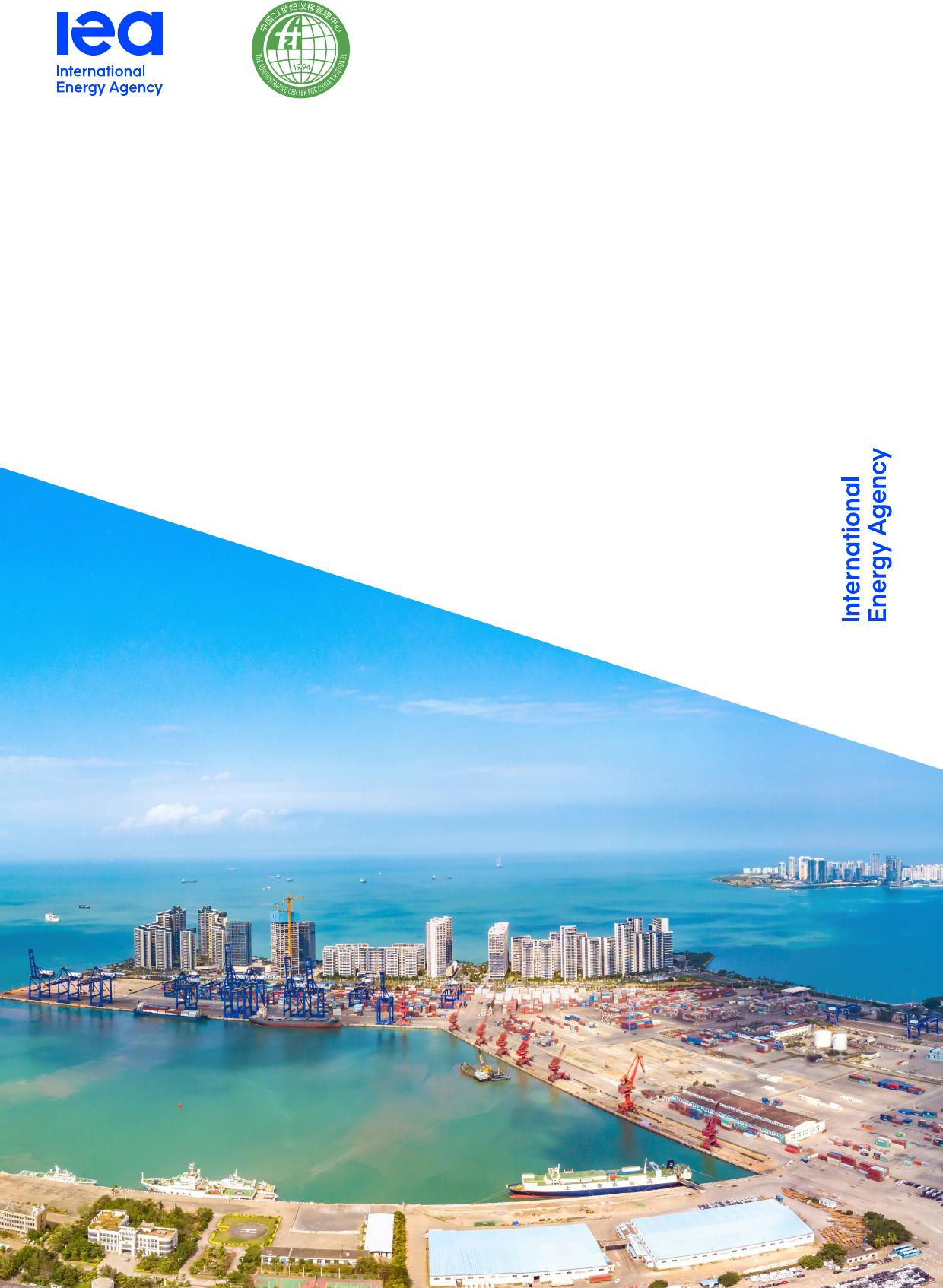OpportunitiesforHydrogenProductionwithCCUSinChinaTheIEAexaminesthefullspectrumofenergyissuesincludingoil,gasandcoalsupplyanddemand,renewableenergytechnologies,electricitymarkets,energyefficiency,accesstoenergy,demandsidemanagementandmuchmore.Throughitswork,theIEAadvocatespoliciesthatwillenhancethereliability,affordabilityandsustainabilityofenergyinits31membercountries,11associationcountriesandbeyond.Pleasenotethatthispublicationissubjecttospecificrestrictionsthatlimititsuseanddistribution.Thetermsandconditionsareavailableonlineatwww.iea.org/t&c/Thispublicationandanymapincludedhereinarewithoutprejudicetothestatusoforsovereigntyoveranyterritory,tothedelimitationofinternationalfrontiersandboundariesandtothenameofanyterritory,cityorarea.Source:IEA.Allrightsreserved.InternationalEnergyAgencyWebsite:www.iea.orgIEAmembercountries:AustraliaAustriaBelgiumCanadaCzechRepublicDenmarkEstoniaFinlandFranceGermanyGreeceHungaryIrelandItalyJapanKoreaLithuaniaLuxembourgMexicoNetherlandsNewZealandNorwayPolandPortugalSlovakRepublicSpainSwedenSwitzerlandRepublicofTürkiyeUnitedKingdomUnitedStatesTheEuropeanCommissionalsoparticipatesintheworkoftheIEAIEAassociationcountries:ArgentinaBrazilChinaEgyptIndiaIndonesiaMoroccoSingaporeSouthAfricaThailandUkraineINTERNATIONALENERGYAGENCYOpportunitiesforHydrogenProductionwithCCUSinChinaAbstractPAGE3IEA.Allrightsreserved.AbstractHydrogenandcarboncapture,utilisation,andstorage(CCUS)aresettoplayimportantandcomplementaryrolesinmeetingPeople’sRepublicofChina’s(hereafter,“China”)pledgetopeakcarbondioxideemissionsbefore2030andachievecarbonneutralitybefore2060.HydrogencouldcontributetoChina'senergysystemdecarbonisationstrategy,suchasthroughtheuseasafuelandfeedstockinindustrialprocesses;infuelcellelectrictransport,andfortheproductionofsynthetichydrocarbonfuelsforshippingandaviation.Theanalysisofscenariosinthisreportsuggeststhatwhilehydrogenfromrenewablepowerelectrolysiscouldmeetthemajorityofhydrogendemandby2060,equippingexistinghydrogenproductionfacilitieswithCCUScouldbeacomplementarystrategytoreduceemissionsandscale-uplow-emissionhydrogensupply.ThisreportwasproducedincollaborationwiththeAdministrativeCentreforChina’sAgenda21(ACCA21).Itexplorestoday’shydrogenandCCUSstatusinChina,andthepotentialevolutionofhydrogendemandinvarioussectorsoftheChineseeconomythrough2060,inlightofscenariosdevelopedindependentlybytheIEAandtheChinaHydrogenAlliance.Thereportalsoprovidesacomparativeassessmentoftheeconomicperformanceandlifecycleemissionsofdifferenthydrogenproductionroutes.Finally,thereportdiscussespotentialsynergiesandregionalopportunitiesindeployingCCUSandhydrogen,andidentifiesfinancingmechanismsandsupportingpoliciesrequiredtoenablethedeploymentofhydrogenproductionwithCCUSinChina.OpportunitiesforHydrogenProductionwithCCUSinChinaAcknowledgementsPAGE4IEA.Allrightsreserved.Acknowledgements,contributorsandcreditsThisreportistheresultofacollaborationbetweentheEnergyTechnologyPolicyDivision,ledbyTimurGül,intheDirectorateofSustainability,TechnologyandOutlooksattheInternationalEnergyAgency(IEA),andtheAdministrativeCenterforChina'sAgenda21(ACCA21),directedbyJingHuang.TheleadIEAauthorwasMathildeFajardytogetherwithformerIEAstaffNielsBerghoutandDongXu,withsignificantinputandguidancefromSamanthaMcCulloch(formerIEAheadofCCUSunit).ThereportalsobenefitedfromvaluableinputsandcommentsfromotherexpertswithintheIEA,includingPraveenBains,SimonBennett,JoseMiguelBermudezMenendez,SaraBudinis,ElizabethConnelly,AraceliFernandezPales,CarlGreenfield,PeterLevi,RebeccaMcKimm,RachaelMoore,UweRemme,andErpuZhu.ZhiyuYang,BiqingYang,andCarolineAbettanprovidedessentialsupport.TheleadACCA21authorwasXianZhang.JingHuang,BingKe,andQizhenChenprovidedsignificantreviewandguidance.MingweiShiandXuetingPengcontributedvaluabledataandanalysistothereport,assistedbyQiaoMa,GuoweiJia,JiayanLiu,HaodongLv,DongyangZhang,XuejingZhang,andNianYang.SeveralexpertsfromChineseorganisationsandresearchinstitutesalsocontributedvaluableanalysisandinputtothereport.Yi-MingWei,deputypresidentoftheBeijingInstituteofTechnology(BIT),coordinatedinputandanalysisfromallexpertChineseorganisations.Thelistofcontributorsincluded:•ChinaHydrogenAllianceResearchInstitute(CHARI),withvaluableinputandcontributionsfromYanmingWan,assistedbyYalinXiong,XueyingWang,ChenjiangXiaoandunderthecoordinationofWeiLiu.•NewEnergyTechnologyResearchInstitute(NETRI),ChinaEnergy,withvaluableinputandcontributionfromDongXu,assistedbyZhiyongWang,andunderthecoordinationofQingruCui.•BeijingInstituteofTechnology(BIT),withvaluableinputandcontributionfromJiaquanLi,assistedbyXiaoyuLi,BoYang,HuaLiao,QiaomeiLiang,JianingKang,YunlongZhang,LutaoZhao,MinDai,ShuoXu,HongkunCui,SongPeng,andYizhuoJi,andunderthecoordinationofYi-MingWei.•BeijingNormalUniversity(BNU),withvaluabledataandanalysisprovidedbyLancuiLiu.OpportunitiesforHydrogenProductionwithCCUSinChinaAcknowledgementsPAGE5IEA.Allrightsreserved.•ChinaUniversityofMining&Technology-Beijing(CUMTB),withvaluableinputandcontributionsfromJingliFan,assistedbyKaiLi,YuxuanWang,XiaojuanXiang,YifanMao,YujiaoXian,andBingWang.•InstituteofRockMassandSoilMechanics,ChineseAcademyofSciences(IRSM,CAS),withvaluabledataandanalysisprovidedbyNingWei,assistedbyShengnanLiu.TheIEACommunicationsandDigitalOfficealsoassistedandcontributedtotheproductionofthefinalreportandwebsitematerials,particularlyAstridDumond,ClaraVallois,LucileWall,andThereseWalsh.ThereportwaseditedbyKristineDouaud.XianZhang(ACCA21)andDongXu(NETRI)coordinatedthetranslationofthereport,withsupportfromMingweiShi(ACCA21),ZhiyongWang(NETRI),JiaquanLi(BIT),YanmingWan(CHARI),LancuiLiu(BNU),JingliFan(CUMT),NingWei(IRMSM),ZhiyuYang(IEA),BiqingYang(IEA),andRebeccaMcKimm(IEA).OpportunitiesforHydrogenProductionwithCCUSinChinaTableofcontentsPAGE6IEA.Allrightsreserved.TableofcontentsExecutiveSummary.................................................................................................................7Chapter1.China’shydrogenopportunity...........................................................................11China’scarbonneutralitypledge..............................................................................................11Thevalueofhydrogenforemissionsreductions.....................................................................12HydrogeninChinatoday..........................................................................................................13China’shydrogenopportunity..................................................................................................14CCUSinlow-emissionhydrogenproduction...........................................................................18Low-emissionhydrogenstandardsinChina............................................................................23Chapter2.OutlookforChina’shydrogenindustry............................................................26ModellingthefutureroleofhydrogeninChina........................................................................27OutlookforhydrogenproductionanddemandinChina..........................................................27Hydrogeninindustryandfueltransformation..........................................................................30Hydrogenintransportation.......................................................................................................33Hydrogenforpowergeneration................................................................................................35Hydrogenuseinbuildings........................................................................................................35Chapter3.Productionroutesforlow-emissionhydrogen................................................37HydrogenwithCCUS...............................................................................................................37Otherlow-emissionroutes.......................................................................................................40Comparisonsofhydrogenproductionroutes...........................................................................46Chapter4.Fosteringhydrogen-CCUSsynergies...............................................................51PotentialsynergiesbetweenhydrogenandCCUS..................................................................52Co-locatinghydrogenandCCUSinindustrialclusters............................................................52Low-costCO2captureopportunities........................................................................................53GeneratingrevenuesfromCO2use.........................................................................................54Combiningbioenergy-basedhydrogenproductionwithCCUSforcarbonremoval................60Policyrecommendations..........................................................................................................61References..............................................................................................................................64Appendices.............................................................................................................................67AppendixA.HydrogenprojectsinChina.................................................................................67AppendixB.CasestudyonaCCUS-equippedcoal-to-chemicalplantinChina.....................69Abbreviationsandacronyms....................................................................................................74Glossary...................................................................................................................................74OpportunitiesforHydrogenProductionwithCCUSinChinaExecutiveSummaryPAGE7IEA.Allrightsreserved.ExecutiveSummaryChina’shydrogenandCCUSopportunityHydrogenandCCUSaresettoplayimportant,complementaryrolesinmeetingthecarbonneutralitygoalsofChina.ChinahaspledgedtopeakCO2emissionsbefore2030andachievecarbonneutralitybefore2060,requiringaprofoundtransformationofitsenergysystem.Low-emissionhydrogenandcarboncapture,utilisationandstorage(CCUS)technologieshavebothbeenidentifiedaskeyprioritiesinChina’scarbonneutralityguidelines.Chinaleadstheworldinhydrogenproduction,butthisproductioniscurrentlyemissions-intensive.In2020,hydrogenproductioninChinareachedaround33Mt,or30%oftheworldtotal.China’sleadingpositionresultsfromitslargeshareoftheglobalchemicalmarketanditsconsiderableoilrefiningcapacity,whicharetheprimarysourcesofhydrogendemandtoday.Chinaistheonlycountryintheworldthatproduceshydrogenfromcoalatsignificantscale:abouttwo-thirdsofChina’shydrogenproductionisfuelledbycoal,witharound360MtofCO2emissionsgeneratedin2020.EquippingexistinghydrogenproductionfacilitieswithCCUSisakeystrategytoreduceemissionsandenlargethecountry’slow-emissionhydrogensupply.ForhydrogentocontributetoChina’scarbonneutralitygoal,anambitiousshifttolow-emissionproductionisessential.Themostpromisinglow-emissionroutesincludeproducinghydrogenfromrenewableelectricitythroughelectrolysisorequippingfossilfuel-basedproductionrouteswithCCUS.AsmanyofChina’sexistingcoal-basedhydrogenplantswerebuiltrecently,arehighlyemissions-intensiveandcouldbeinoperationfordecadestocome,equippingthemwithCCUScouldbecriticaltoreducetheiremissions.CCUScouldalsoprovideaviablecost-effectivesupplyoptionfornewhydrogencapacityinregionswithabundantcoalresourcesandopportunitiesforCO2storage.GiventhelowavailabilityofindigenousnaturalgasresourcesinChinaandthecountry’slargecoalgasificationfleet,coal-to-hydrogenproductionwithCCUSisexpectedtopersistasanimportantfossilfuel-basedhydrogengenerationroute.Nevertheless,electrolysisislikelytopredominatefromthe2030s.Infact,anticipatedelectrolyserandrenewableenergycostreductionscouldmeanthatrenewableelectricity-basedelectrolytichydrogenwouldmakeupasmuchas80%ofChina’shydrogensupplyby2060.OpportunitiesforHydrogenProductionwithCCUSinChinaExecutiveSummaryPAGE8IEA.Allrightsreserved.AgrowingroleforhydrogenacrosstheeconomyHydrogenusecouldtacklearangeofenergyandemissionschallengesinChina.Low-emissionhydrogencouldbeemployedinarangeofsectors(includinglong-distancetransport,chemicals,andironandsteel)toachievedeepemissionsreductions.Developinghydrogenasanenergyvectorcanalsoimproveairquality,reducerelianceonfuelimportsanddrivetechnologicalinnovation.Forthesereasons,ChinaHydrogenAlliance(CHA)hasestablishedaninitiativetoraisetheshareofhydrogeninChina’sfinalenergydemandto20%in2060.HydrogenissettohaveacrucialroleinChina’sstrategytoachievecarbonneutralityby2060.TheIEAAnnouncedPledgesScenario(APS)suggeststhathydrogendemandcouldincreasemorethanthreefoldby2060forChinatomeetitsclimategoals.Nearlytwo-thirdsofthisgrowthislinkedtohydrogenandhydrogen-basedfueluseintransport,andaroundone-thirdisassociatedwithusinghydrogenasafuelandforfeedstockinindustrialprocesses.Demandforhydrogengrowsto31Mtin2030undertheAPS,owingpartlytotheconventionaluseofhydrogeninmethanolproduction,oilrefiningandcoal-to-chemicalsproduction,althoughnoveluses(includingasafuelorfeedstockinnon-chemicalindustries,andinthetransportandbuildingssectors)alsogaingroundslowly.Thehydrogenmarketgrowsstronglyduringthe2030storeachjustover90Mtby2060,mainlybecauseofrapidmarketexpansionforfuelcellheavy-dutytrucksandhydrogen-basedfuelsforshippingandaviation,andfromrisingfuelandfeedstockdemandforindustrialprocesses.TargetedsupportcouldexpandChina’suseofhydrogen.CHAanalysisshowsthattargetedpoliciesandsupportforhydrogencouldresultinevengreatermarketuptakeofhydrogen.IntheCHAstudy,whichisadetailedbottom-upassessmentofhydrogen’stechnicalandcommercialpotentialoutsidethecontextofanenergysystemmodellingframework,hydrogendemandrisesto37Mtby2030andto130Mtby2060,withparticularlystronggrowthinhydrogenandhydrogen-basedfuelsfortransportaswellasforuseinindustry.CCUSsupportscost-competitivehydrogenexpansionProducinglow-emissionhydrogenfromcoalwithCCUSwillbealow-costoptioninregionsofChinawithabundantcoal,accesstoCO2storageandlimitedrenewableenergyavailability.HydrogenproductioncostsinChinavarybyregionbasedonseveralfactors,withcapitalcostsandthecostandavailabilityofrenewableenergybeingkeydeterminants.Forinstance,theaveragecostofproducinghydrogenfromcoalwithCCUSiscurrentlyUSD1.4-3.1/kgH2,whilegeneratingelectrolytichydrogenusingrenewableelectricityismoreexpensiveatUSD3.1-9.7/kgH2,dependingontheoriginandavailabilityoftheelectricity.OpportunitiesforHydrogenProductionwithCCUSinChinaExecutiveSummaryPAGE9IEA.Allrightsreserved.However,costsareprojectedtodropsubstantiallyinthemediumterm,potentiallyfallingtoaroundUSD1.5/kgH2inthelongerterminregionswithamplesolarandwindresources.CO2captureratesmustbehighandupstreamemissionslowtoensurethatcoal-basedproductionrouteswithCCUSaretrulylow-emission.WithCO2captureratesof90-95%andupstreamfuelemissionsaccountedfor,thegreenhousegas(GHG)emissionsintensityoflow-emissionhydrogenproducedfromfossilfuelswithCCUSinChinacouldbe3.5-4.5kgCO2-eq/kgH2forcoal-basedproductionand2.6-3.1kgCO2-eq/kgH2fornaturalgas-based.WhileproducingelectrolytichydrogenwithgridelectricitywouldresultinaGHGemissionsintensityof29-31kgCO2/kgH2inthecurrentelectricitysystem,electrolytichydrogenproducedfromrenewablesaverages0.3-0.8kgCO2/kgH2,includingemissionsgeneratedfromthemanufacturingofthehydrogenproductionunits.Theemissionsintensitiesofbothcoal-andgas-basedproductionwithCCUScouldthereforemeetChina’scurrent“cleanhydrogen”standardofbelow4.9kgCO2/kgH2(theworld’sfirstformalstandard).However,thresholdswilllikelyhavetobeloweredovertime,includingtomeetinternationalmarketstandardscurrentlyunderdevelopment.Nurturinghydrogen-CCUSsynergiescanhelpChinaachievecarbonneutralityDeployinghydrogenproductionandCCUStogethercanbemutuallybeneficialandreinforcing.BecausehydrogenproductionoffersarelativelypureCO2stream,equippingfacilitieswithCCUSisaleast-costCO2captureoption.Atthesametime,itofferstheChinesegovernmentearlyopportunitiestodevelopCCUStechnologiesandtosupportinvestmentinCO2infrastructureinthecountry.IntheAPS,2.6GtCO2iscapturedacrosstheChineseenergysectorin2060.Industrialclusterscanserveasnervecentrestoscale-uplow-emissionhydrogenproductionandCCUSdeployment.Bothhydrogensupplyanddemandaremorelikelytobeconcentratedinindustrialclusters,someofwhicharelocatednearpotentialCO2storagesites.Thus,retrofittingexistingcapacitywithCCUSwouldbealow-costwaytoexpandlow-emissionhydrogeninfrastructurewhilesimultaneouslyrollingoutfacilitiesforCO2transportandstorage.Plus,owingtotheco-locationofpotentialdemand(e.g.forheavy-dutytrucks),clustersarealsopromisingsitesfromwhichtoextendhydrogenusetoothersectors.CapturedCO2andhydrogenarekeyinputsforthefutureproductionofsyntheticfuels.Despitetheircurrentlyhighproductioncosts,syntheticfuelsareoneofthefewsolutionstoreduceemissionsfromlong-distancetransport,particularlyaviation,forwhichthedirectuseofhydrogenandelectrificationareOpportunitiesforHydrogenProductionwithCCUSinChinaExecutiveSummaryPAGE10IEA.Allrightsreserved.challenging.CapturedCO2inChinacanalsobeusedforenhancedoilrecovery(CO2-EOR)ortomanufacturechemicalsorbuildingmaterials.InapplicationsforwhichtheCO2isre-releasedintotheatmosphere(includingthroughsyntheticfuelcombustion),carefulaccountingisneededtovalidateemissionsreductions.ProducinghydrogenfrombioenergywithCCUScouldcontributetocarbonremovalandbalanceemissionsfromotherpartsoftheeconomy.CarbonremovalwillneedtobeanimportantpartofChina’splantoachieveitscarbonneutralitygoals,includingtobalanceresidualemissionsfromtheindustryandtransportsectors.Whileitisstillatarelativelyearlystageoftechnologydevelopment,producinghydrogenfrombiomasswithCCUScouldhelpenablecarbonremoval.However,thisproductionrouterequiresaccesstoasustainablebiomasssupply,whichmaybethreatenedbycompetingclaimsonitforotheruses,includingforfuelproduction(e.g.biokerosene).OpportunitiesforHydrogenProductionwithCCUSinChinaChapter1.China’shydrogenopportunityPAGE11IEA.Allrightsreserved.Chapter1.China’shydrogenopportunityHIGHLIGHTS•Low-emissionhydrogencanbeanimportantpartofChina’sstrategytoachievecarbonneutralityby2060.Itoffersameanstoaccomplishdeepemissionsreductionsinarangeofsectors,includinglong-distancetransport,chemicals,andironandsteel.Itsusecanalsohelpimproveairquality,reducerelianceonfuelimportsanddrivetechnologicalinnovation.•Chinaisthegloballeaderinhydrogenproductionanduse.In2020,itshydrogenproductionwas26-33Mt(dependingonhowby-producthydrogenproductionisconsidered).China’sleadingpositionstemsfromitslargechemicalindustryandoilrefiningcapacity,whicharethemainsourcesofhydrogendemandtoday.•Overtwo-thirdsofChina’sdedicatedhydrogenproductioncurrentlycomesfromcoalandalmostalltheremainderfromnaturalgas,soitisassociatedwithsignificantemissions.AccordingtotheIEA,hydrogenproductionisresponsibleforaround360MtCO2emissions(excluding115MtCO2capturedandusedinmethanolandureaproduction).•Carboncapture,utilisationandstorage(CCUS)cansupporttheaccelerated,cost-effectivescale-upoflow-emissionhydrogenproductioninChina.ThemainroleforCCUSistotackleemissionsfromexistinghydrogenplants,manyofwhichcouldbeinoperationfordecadestocome.Itmayalsoprovideacost-competitivesupplyoptionfornewhydrogencapacityinregionswithlow-costcoalandCO2storage,aswellasinareaswithmeagrewindandsolarresources.China’scarbonneutralitypledgeInSeptember2020,PresidentXiJinpingpledgedtotheUnitedNationsGeneralAssemblythatChinawouldaimtopeaknationalCO2emissionsbefore2030andachievecarbonneutralitybefore2060.Thisannouncementwasamajormilestoneininternationalclimatepolicyandhashadarippleeffectonclimateactionglobally.AccordingtotheIEA,Chinawasresponsibleforone-thirdofglobalenergy-relatedCO2emissionsin2020,orover11billiontonnes(Gt)(IEA,2021a).OpportunitiesforHydrogenProductionwithCCUSinChinaChapter1.China’shydrogenopportunityPAGE12IEA.Allrightsreserved.Transitioningtoacarbon-neutraleconomywilldemandarapidandprofoundtransformationofChina’senergysector,requiringabroadportfoliooftechnologiestodeliverdeepemissionsreductionsacrossalleconomicsectors.Rapidrisesinenergyefficiencyandrenewableenergyproductionarecentral,butamajoraccelerationindeployingarangeofcleanenergytechnologies–includinghydrogenandCCUS–willalsobeneededtoreachcarbonneutrality.ThevalueofhydrogenforemissionsreductionsHydrogenholdsgreatpromiseforaidingthetransitiontoalow-emissionenergysystem.Ithasmanypossibleapplicationsacrossarangeofsectorsandisparticularlyvaluableinthoseforwhichfewalternativeemissionsmitigationsolutionsexist,suchaslong-distancetransportandheavyindustry.Potentialapplicationsincludeitsuseinfuelcellelectricvehicles(FCEVs),asafeedstockformanufacturingchemicalsandsynthetictransportfuelssuchasammoniaandkerosene,asareducingagentinindustrialprocessessuchasironandsteelproduction,andinsomeplacestoheatbuildings.Hydrogencanbeproducedfromavarietyofenergysources,includingnaturalgas,coal,biomassandrenewableandnuclearelectricity.Furthermore,electrolysisofwater–aprocessinwhichwaterissplitintohydrogenandoxygen–allowsfortheindirectuseoflow-emissionelectricityinothereconomicsectorsinwhichelectrificationischallenging.Hydrogenusetodayisdominatedbyindustrialapplicationsandoilrefining.Globally,thetopthreesingleusesofhydrogen(bothinpureformandmixedwithothergases)are:oilrefining(43%),ammoniaproduction(36%)andmethanolproduction(14%)(IEA,2021b).Globaldemandforhydrogenhasgrownrapidlyinrecentdecades–fromcloseto60Mt/yrin2000toaround90Mt/yrin2020–andissettoincreasefurther.Inenergyterms,totalannualhydrogendemandworldwidewasjustover10EJin2020.1Thecarbonfootprintofhydrogendependsmainlyontheprimaryenergysourceusedtoproduceit.EventhoughhydrogendoesnotemitCO2whenitisused,itsproductioncurrentlyleavesaconsiderablecarbonfootprintbecauseofthewidespreaduseofcoalandgas.Theoverwhelmingmajorityofhydrogenproducedaroundtheworldisfromfossilfuels,witharound80%ofitcomingfrom“dedicated”hydrogenproductionfacilitiesin2020,meaningthathydrogenistheprimaryproduct.Mostofthisproductionisfuelledbyunabatednaturalgas(74%)andcoal1Thisincludesmorethan70MtH2usedaspurehydrogenandlessthan20MtH2mixedwithcarbon-containinggasesinmethanolproductionandsteelmanufacturing.Itexcludesaround30MtH2presentinresidualgasesfromindustrialprocessesusedforheatandelectricitygeneration:asthisuseislinkedtotheinherentpresenceofhydrogenintheseresidualstreams–ratherthantoanyhydrogenrequirement–thesegasesarenotconsideredhereashydrogendemand.OpportunitiesforHydrogenProductionwithCCUSinChinaChapter1.China’shydrogenopportunityPAGE13IEA.Allrightsreserved.(24%),correspondingtoaround240bcmofnaturalgas(6%ofglobalnaturalgasdemandin2020)and115Mtceofcoal(2%ofglobaldemand).Theremaining20%ofglobalsupplyis“by-product”hydrogen,meaningthatitcomesfromfacilitiesandprocessesdesignedprimarilytoproducesomethingelse,suchasironandsteelormethanol.Thisby-producthydrogenoftenneedsdehydratingorothertypesofcleaningbeforeitcanbesenttoavarietyofhydrogen-usingprocessesandfacilities.Catalyticnaphthareforming(CNR)inrefineriesisoneofthemainsourcesofby-producthydrogen.In2020,lessthan0.8%oftotalhydrogenproductionwasfromwaterelectrolysis(~0.03%)orfromfossilfuelplantsequippedwithCCUS(~0.7%oftotalproduction)–thetwomostmaturelow-emissionhydrogenproductionroutescurrentlyavailable.Asaresult,bothdedicatedandby-producthydrogenproductiongloballyemittedcloseto900MtCO2in20202(IEA,2021b).HydrogeninChinatodayChinahasbeentheworld’slargestproducerandconsumerofhydrogensince2010,owingtogrowingdemandfromitsindustrysectorandtheavailabilityoflow-costresources.Since2010,accordingtodatasourcesinChina,nationalhydrogenconsumptionhasincreasedanimpressive30%toreacharound33Mtin2020,accountingforaround30%oftheglobaltotal(CHA,2020a).Thisincludeshydrogenusedforonsiteco-generationofheatandpowerinindustrialprocesses,suchascoal-cokinginsteelmakingandchlor-alkalielectrolysisinchlorineandcausticsodaproduction.Dedicatedhydrogenproductionandby-producthydrogenproductionfromcatalyticnaphthareforming(whichisgenerallythebasisofIEAestimates)amounttoaround26Mt3(IEA,2021a).Chinadominatesglobalhydrogendemand,asithasroughly30%oftheworld’scombinedcapacityforproducingammonia,methanolandhigh-valuechemicals(IEA,2021a).Italsohasthesecond-largestoilrefiningcapacityglobally,totalling17Mb/din2021(IEA,2021c).Ammoniaproduction(10-11Mt/yr,dependingonthedatasource)andoilrefining(8-9Mt/yr)arethelargestconsumersofpurehydrogen,andmethanolproduction(7-9Mt/yr)useshydrogenmixedwithothergases(e.g.carbonmonoxide)asarawmaterial.Another5Mt/yrofhydrogenisproducedandusedonsiteasafueltoprovidehigh-temperatureheatforotherindustrialprocesses(CHA,2020a).Justunder0.02Mtofpurehydrogendemandiscurrentlyallocatedtonoveltransportationpurposes,mainlyFCEVs.42Thisincludes265MtCO2capturedandusedonsiteinammoniaandmethanolproduction(andultimatelyreleasedtotheatmosphere).3AstheuseofH2presentinresidualgasesfromindustrialprocessesusedforheatandelectricitygeneration(coal-cokinginsteelmaking,chlor-alkalielectrolysisinchlorineandcausticsodaproduction)islinkedtotheinherentpresenceofhydrogenintheseresidualstreams–ratherthantoanyhydrogenrequirement–thesegasesarenotconsideredashydrogendemandinIEAdefinitions.4Hydrogencurrentlyusedinthetransportsectorismainlyby-producthydrogen.OpportunitiesforHydrogenProductionwithCCUSinChinaChapter1.China’shydrogenopportunityPAGE14IEA.Allrightsreserved.CoalisthefuelusedformostofChina’shydrogenproduction,withnearlytwo-thirds(21Mt)madethroughcoalgasification,accountingfor5%ofChina’stotalcoalconsumption.Naturalgasreformingistheothermainmeansofdedicatedhydrogenproduction(5Mt),andonlyaverysmallfractionoftoday’shydrogencomesfromwaterelectrolysis.Theremainder(7Mt)isformedasaby-productofseveralprocesses:coal-cokinginsteelmaking;chlor-alkalielectrolysisinchlorineandcausticsodaproduction;dehydrogenation;crackingoflightoilfractions;andcatalyticnaphthareforming(CHA,2020a).HydrogenproductionanddemandinChina,2020IEA.CCBY4.0.Notes:By-producthydrogenincludeshydrogenproducedfromcoal-cokinginsteelmaking;chlor-alkalielectrolysisinchlorineandcausticsodaproduction;dehydrogenation;crackingoflightoilfractions;andnaphthacatalyticreforming.Dedicatedhydrogenproductionandby-producthydrogenfromcatalyticnaphthareforming(whichisgenerallythebasisofIEAestimates)amounttoaround26Mt.Source:CHA(2020a),ChinaHydrogenEnergyandFuelCellIndustryDevelopmentReport.IEAanalysisshowsthatthewidespreaduseoffossilfuelsforhydrogenproductionresultsinannualemissionsofaround360MtCO2(thisexcludes115MtCO2capturedandusedinmethanolandureaproduction).China’shydrogenopportunityTheChinesegovernmentaimstoexpandlow-emissionhydrogenproductionandcreatenewenduses,forexamplebyusingitasafuelforFCEVstoaddresstheissuesofairpollutionandthecurtailmentofrenewableelectricitygenerationfromsolarPVandwindresources.Chinahasbeenactivelydevelopingahydrogenindustryformanyyears,promptedbyeconomicandotherimperativesinadditiontoclimateconcerns:0510152025303540HydrogenproductionMt/yrBy-productElectrolysisNaturalgasCoal0510152025303540HydrogendemandMt/yrOtherAmmoniaMethanolIndustry(fuelandfeedstock)TransportRefiningOpportunitiesforHydrogenProductionwithCCUSinChinaChapter1.China’shydrogenopportunityPAGE15IEA.Allrightsreserved.Theopportunitytobecomeagloballeaderinhydrogentechnologies.Technologicalinnovationcouldopenupnewmarkets,bothdomesticandinternational,andpromoteeconomicgrowth.Innovation-drivengrowthfitswellwiththegovernment’s14thFive-YearPlan(FYP)anditstechnologicalself-reliancestrategy.Thedesiretoreducelocalairpollution.Whilewidespreadfossilfueluseinindustrialmanufacturingandtransportisamajorsourceofairpollution,hydrogencanbeusedinvehiclesandheatingapplicationswithoutproducingthesameparticulatematteroremissions.UrbanairpollutionanditsrelatedhealthandenvironmentalimpactsarenowmajorconsiderationsinChina’senergypolicydecisions.Theneedtoimproveenergysupplysecurity.Chinareliesheavilyonimportedoiland,especially,gas.Hydrogenhasthepotentialtodiversifyprimaryenergysupplybyallowingthecountrytoshiftpartlytomoreaffordabledomesticresourcessuchascoal(whenusedwithCCUS)andrenewableenergy,includingwind-andsolar-basedgenerationthatwouldotherwisebecurtailed.ThevastnessofChina’sdomesticresourcebasecouldevenallowthecountrytoexporthydrogeninthefuture.Indeed,theChinaHydrogenAlliance’s(CHA’s)detailed2020analysishighlightedtheconsiderableopportunitiesforChina’shydrogensector,includingusinghydrogenforFCEVs,asafuelandfeedstockinindustrialprocesses,andintheproductionofsyntheticfuels,identifiedaskeymarketsforfuturehydrogenuse(CHA,2020a).China’ssupportforhydrogenChina’slonghistoryofsupportinghydrogenandfuelcelldevelopmentdatestoearlyresearchactivitiesinthe1950s.Sincethe1980s,severalgovernmentprojectshavebeenlaunchedtoacceleratehydrogentechnologydevelopmentandcommercialisationthroughthe863Programmeandthe973Programme.In2019,thegovernmentspentoverCNY2billion(USD300million)onhydrogen-relatedresearch,developmentanddemonstration(RD&D)programmes(CHA,2020b).China’shydrogenR&Dhistory,1991-2020PeriodResearchanddevelopmentprocessFunding1991-1995•ChangchunInstituteofChemistrycarriedoutresearchonPEMFC.•ShanghaiInstituteofCeramics,InstituteofChemicalMetallurgyandTsinghuaUniversitystartedresearchonfuelcells.1996-2000•ResearchonPEMFCandfuelcellsystems.CNY40mln(USD6mln)OpportunitiesforHydrogenProductionwithCCUSinChinaChapter1.China’shydrogenopportunityPAGE16IEA.Allrightsreserved.PeriodResearchanddevelopmentprocessFunding2001-2005•StateHigh-TechDevelopmentPlan(863Programme):FCEVresearchcarriedoutbyDICP.•PEMFCandhydrogenstoragetechnologiesstudiedatTsinghuaUniversityandZhejiangUniversity.CNY1200mln(USD180mln)2006-2010•NationalBasicResearchProgramme(973Programme)and863Programme:researchonhydrogenproduction,hydrogenstorageandfuelcellmodulematerials.CNY350mln(USD53mln)2011-2015•MinistryofScienceandTechnologyheldseminaronhydrogenandfuelcelltechnologyatWuhanUniversityofTechnologyduring13thFYPperiod,focusingondevelopmentoffuelcells,FCEVsandtheirkeytechnologies.CNY160mln(USD24mln)2016-2020•Inceptionoffuelcelltechnologyinnovationplatform;attentiontomethanolfuelcelldevelopment;expandingapplicationfieldforsmall-scalefuelcellsanddemonstrationandoperationofFCEVs.CNY500mln(USD75mln)Notes:DIPC=DalianInstituteofChemicalPhysics.PEMFC=protonexchangemembranefuelcell.Source:CHA(2020b),ChinaHydrogenandFuelCellIndustryHandbook.Duringthe13thFive-Year-Planperiod(2016-2020),activityinvolvinghydrogenandfuelcellswasrampedup,withtheMinistryofScienceandTechnologysupporting27hydrogenRD&DprojectsthroughtheRenewableEnergyandHydrogenTechnologyprogramme.Inaddition,threespecialhydrogentechnologyprojectswereintroducedforthe2022BeijingWinterOlympics,includingtheconstructionofhydrogenproductionandstoragefacilities,andtheintroductionof1000fuelcellbusesandassociatedrefuellinginfrastructure(seeAppendix1forcompleteprojectlist)(CHA,2020b).In2015,theStateCouncillistedhydrogenproductionandFCEVsamongthekeytechnologiesoftheMadeinChina2025Initiative.PolicyandregulatorydevelopmentsinthelastthreeyearsindicatethathydrogenisgainingstrategicinterestinChina.Forinstance,tenpolicydocumentsmentioninghydrogenwereissuedin2019,includingtheimportantStateCouncil’sWorkReport,whichemphasisedhydrogeninfrastructuredevelopment.Inthefirsthalfof2020,sixmorepolicydocumentsfromdifferentministriesexpressedsupportforhydrogen-relatedtechnologies,particularlyforthetransportsector(YueandWang,2020).InApril2020,theNationalEnergyAdministrationintroducedhydrogenasanenergycarrierinthedraftEnergyLaw.Followingthistrend,thehydrogeneconomyfeaturesprominentlyinsubsectorplansforthe14thFive-YearPlanadoptedinMarch2021.InMarch2022,theNationalDevelopmentandReformCommissionreleasedtheMediumandLong-OpportunitiesforHydrogenProductionwithCCUSinChinaChapter1.China’shydrogenopportunityPAGE17IEA.Allrightsreserved.TermPlanforDevelopmentoftheHydrogenEnergyIndustry(2021-2035),China’sfirstmedium-termplanforestablishingalow-emissionhydrogenindustry.Theplanaimstodeploy50000FCEVsby2025,produce0.1-0.2Mtofrenewablehydrogenannually(usingelectrolysisorbioenergy),andexpandhydrogeninfrastructureby2035(China,NDRC,2022).Interestinhydrogenisalsogrowingamonglocalandregionalgovernments.Attheendof2019,atleasttenprovincesandmunicipalitieshadissuedactionplansforhydrogenandfuelcells,whichhavebeenidentifiedaseconomicgrowthopportunities.Duringthefirstsixmonthsof2020alone,localgovernmentspublished30policiessupportinghydrogen(Tu,2020).ThesuccessofthepoliciesisreflectedinrisingFCEVsales,andgrowthinotherhydrogen-relatedindustries.Inrecentyears,thegovernmentsofBeijing,Guangdong,Hebei,Jiangsu,ShandongandShanghaiaswellasotherlocalgovernmentshavereleasedregionalhydrogendevelopmentplans,basedontheirindustriesandresourcebases.Infact,theseprovincesandcitiesnowhostaroundhalfofallnewhydrogen-relatedenterprisesinChina.In2020,salesofFCEVsinGuangdong,BeijingandHebeiaccountedfor80%ofChina’stotalsalesforthatyear.Thecity-clustersdemonstrationprogramme,whichaimstostimulateR&Dandthelarge-scaledemonstrationofhydrogenproduction,supply,deliveryanduseinFCEVsinBeijing-Tianjin-Hebei,ShanghaiandGuangdongprovinces,alsoillustratesChina’sambitiontodeployhydrogeninthetransportsector.SelectedpoliciesanddocumentssupportinghydrogendevelopmentinChina,2014-2022YearAuthorityPolicyordocumentKeypurpose2014StateCouncilEnergyStrategicAction(2014-2020)Officiallyadoptedhydrogenandfuelcelltechnologyasthestrategicdirectionintermsofenergytechnologyinnovation.2016CPCCentralCommitteeandtheStateCouncilNationalInnovation-DrivenDevelopmentStrategyProgrammeIndicatedthathydrogenisavitalelementintheenergytechnologydevelopmentstrategy.2018Severalministries,NationalEnergyAdministrationandPeople’sBankofChinaCataloguefortheGuidanceofGreenIndustries2019Encouragedhydrogeninfrastructure,fuelcells,newenergyvehiclesandhydrogenapplicationsinshipping.2019NationalPeople’sCongress(NPC)StateCouncil’sWorkReportPromotedthedevelopmentofhydrogeninfrastructureforthefirsttime.April2020NationalEnergyAdministrationEnergyLaw(draftforcomments)Classifiedhydrogenasanenergysourceforthefirsttime.OpportunitiesforHydrogenProductionwithCCUSinChinaChapter1.China’shydrogenopportunityPAGE18IEA.Allrightsreserved.YearAuthorityPolicyordocumentKeypurposeApril2020NationalEnergyAdministrationNoteonpreparationofthe14thFive-YearPlanforthedevelopmentofrenewableenergyCalledfortheintegrationofnewtechnologies,includinghydrogen.September2021SeveralministriesandtheNationalEnergyAdministrationNoticeondevelopingfuelcellvehicledemonstrationapplicationplan(2021-2025)Thecity-clustersprogrammeselected12citiesinBeijing-Tianjin-Hebei,ShanghaiandGuangdongprovincestocarryoutlarge-scaleFCEVdemonstrations.March2022NationalDevelopmentandReformCommission,andNationalEnergyAdministrationMedium-andLong-TermPlanfortheDevelopmentofHydrogenEnergyIndustry(2021-2035)Targets50000FCEVownershipand0.1-0.2Mtannualrenewable(electrolysisorbioenergy)hydrogenproductionby2025,aswellashydrogeninfrastructurescale-upby2035.MinistryofEcologyandEnvironment;MinistryofHousingandUrban-RuralDevelopment;MinistryofIndustryandInformationTechnology;MinistryofNaturalResources;andtheNationalDevelopmentandReformCommission.MinistryofFinance;MinistryofIndustryandInformationTechnology;MinistryofScienceandTechnology;andtheNationalDevelopmentandReformCommission.Sources:CHA(2020b),ChinaHydrogenandFuelCellIndustryHandbook;IEA(2021a),AnEnergySectorRoadmaptoCarbonNeutralityinChina;China,NDRC(2022),Mediumandlong-termplanforthedevelopmentofhydrogenenergyindustry(2021-2035).CCUSinlow-emissionhydrogenproductionCCUScanplayasignificantanddiverseroleinmeetingChina’sclimateambitions.Itcanofferdeepemissionsreductionsinkeyindustrysubsectorssuchascement,ironandsteel,andchemicals,andcanbeemployedtoreduceemissionsfromexistingcoal-andgas-firedpowerplants.Italsounderpinsanimportanttechnologicalapproachforremovingcarbonfromtheatmosphere,whichisessentialtoachieveanet-zeroenergysystem.CCUStechnologycansupportthescale-upoflow-emissionhydrogenproductionanduseinthreekeywaysby:Reducingemissionsfromexistinghydrogenproductionfacilities.Chinaishometosomeoftheworld’syoungestchemicalproductionandoilrefiningassets.Theaverageageofitscurrentfleetis8yearsformethanolplantsand17forammoniaplants,with30yearsbeingthetypicallifetimeofachemicalplant(IEA,2020a).ThislowaverageagemeansthereisariskofCO2emissionsfromtheseplantsbeinglockedinfordecadestocome.Ifoperatedunderthetypicalconditionsobservedinrecentyears,allofChina’sexistingenergyinfrastructureandplantswouldproducearound175GtCO2ofcumulativeemissionsbetween2020and2060(IEA,2021a).EquippingplantswithCCUSwouldthusenabletheircontinuedoperation,butwithsignificantlyreducedemissions.Today,around15large-scalefacilitiesproducinghydrogenfromfossilfuelswithCCUSareinoperationaroundtheworld,capturingover10MtCO2/yr.Providingacost-effectivemeanstoscale-upnewhydrogenproductioninsomeregions.ThecostofelectrolytichydrogenisexpectedtodropconsiderablyOpportunitiesforHydrogenProductionwithCCUSinChinaChapter1.China’shydrogenopportunityPAGE19IEA.Allrightsreserved.overtimeandbecomeacost-effectiveproductionrouteinChineseregionsthathaveabundantsolarandwindresources.Meanwhile,inotherregions,coal-basedhydrogenproductionwithCCUScansupportthescale-upoflow-emissionhydrogenproductionifmethaneemissionsfromcoalminingcanbeminimised.Coal-basedhydrogenproductionwithCCUSislikelytoremainacost-effectiveoptioninthemediumterminregionswithhighCO2storagecapacity,low-costfossilfuelavailabilityandlimitedrenewableresources.Newfossilfuel-basedhydrogenproductioncapacityequippedwithCCUSisthereforeinplanningorunderconstructioninmultipleregionsaroundtheworld,withthepotentialtogenerateover10Mt/yrofhydrogenandcapturearound80Mt/yrofCO2.SupplyingcapturedCO2andhydrogentoproducetransportfuels.CO2canbeusedtoconverthydrogenintoasyntheticcarbon-basedfuelthatisaseasytohandleanduseasadrop-inreplacementforgaseousorliquidfossilfuels,butwithasmallerCO2footprint.CO2canbecapturedfromarangeoforigins(e.g.concentratedfossilandbiogenicsources,air),butthesourcewillhaveasubstantialimpactontheemissionsreductionsachieved,recognisingthattheutilisedCO2willbereleasedwhenthefueliscombusted.Toachievecarbonneutrality,theCO2wouldincreasinglyneedtobecapturedfrombiogenicsourcesorfromtheair.Syntheticfuelscouldbecomeimportantinsectorsthatwillcontinuetorelyoncarbon-basedfuelsbecausethedirectuseofelectricityorhydrogenischallenging,forexampleaviation.Attheglobalscale,severalcompanieshaveoperatedpilotplantsorarebuildingindustrial-scalefacilitiestoproduceliquidfuelsfromhydrogenandCO2.TheChinesegovernmentisthereforeexploringthepotentialofusinglow-emissionfuelsforlong-haultransport(EnergyFoundationChina,2020).Large-scalefacilitieswithCCUScurrentlyproducinghydrogenaroundtheworldCountryProjectOperationdateApplicationCO2capturecapacity(Mt/year)PrimarystoragetypeUnitedStatesEnidfertiliser1982Fertiliserproduction0.7EORNetherlandsShellheavyresiduegasificationPernis1997Refining0.4EORUnitedStatesGreatPlainsSynfuelplant2000Coal-to-gas3.0EORCanadaHorizonH2capturetailingsCCS2009Refining0.4EORUnitedStatesPCSNitrogen2013Fertiliserproduction0.3EORUnitedStatesPortArthurAirProductsSMR2013Refining0.9EOROpportunitiesforHydrogenProductionwithCCUSinChinaChapter1.China’shydrogenopportunityPAGE20IEA.Allrightsreserved.CountryProjectOperationdateApplicationCO2capturecapacity(Mt/year)PrimarystoragetypeUnitedStatesCoffeyvilleGasification2013Fertiliserproduction1.0EORFrancePortJerome2015Refining0.1UseCanadaQuest2015Hydrogenproduction1.0StorageAbuDhabiAlReyadahphase12016Ironandsteel0.8EORChinaKaramayXinjiangDunhuamethanolplant2016Chemicals(methanol)0.1EORCanadaAlbertaCarbonTrunkLine(ACTL)withAgriumCO2stream2020Fertiliserproduction0.3EORCanadaACTLwithNWRSturgeonRefineryCO2stream2020Hydrogenproduction1.3EORChinaSinopecQiluPetrochemicalShengli2022Fertiliserproduction0.2EORNote:Onlyindustrialfacilitiescapturingatleast0.1Mt/yrofCO2areincluded.Sources:IEAanalysisbasedonIEAtrackingandGCCSI(2021),CCSFacilitiesDatabase2021.CCUSprojectsandpolicysupportinChinaChinahasmadesignificantprogressindevelopinganddeployingCCUSoverthepastdecade.In2021,ithadnearly50CCUSdemonstrationandcommercial-scaleprojectsatvariousstagesofdevelopmentandwithdifferentfocusareas,withatotalplannedcapturecapacityofaround7MtCO2peryear.China’soperationalcommercialanddemonstrationprojectsarecurrentlycapturingcloseto3MtCO2/yr(Zhangetal.,2021a).TheChinaNationalPetroleumCorporation(CNPC)Jilinproject,inoperationsince2008,capturessome600ktCO2peryearfromanaturalgasprocessingplantandtransportsitviaa50-kmpipelinetotheJilinoilfield,whereitisusedforenhancedoilrecovery(CO2-EOR).Meanwhile,constructionoftheSinopecQiluPetrochemicalCCUSfacilitywascompletedinJanuary2022.Itisdesignedtocapture1Mt/yearofCO2fromQilu’srefineriesandtransportit75-150kmbypipelinetooilfieldswhereitwillalsobeusedforCO2-EOR.Theprojectwillgeneratehydrogen,bothasapuregasforammoniaproductionandmixedwithothergasestomanufacturechemicals.Severalsmallercaptureandstoragedemonstrationprojects,mainlyrelatedtocoal-firedpowerplantsandchemicalfacilities,havealsobeenoperatedsuccessfullyoverthelastdecade.OpportunitiesforHydrogenProductionwithCCUSinChinaChapter1.China’shydrogenopportunityPAGE21IEA.Allrightsreserved.DemonstrationandcommercialCCUSfacilitiesinoperationinChinaProjectLocationCO2pointsourceCapturecapacity(kt/yr)CO2storage/useSinopecNanjingChemicalIndustriesCCUSCooperationProjectNanjing(Jiangsu)Chemicalplant200EORCHNEnergyGuohuaPowerJinjieYulin(Shaanxi)Coal-firedpowerplant150EOR35-MWoxygen-enrichedcombustiondemonstrationprojectofHuazhongUniversityofScienceandTechnologyWuhan(Hubei)Coal-firedpowerplant100-CarboncaptureandpurificationdemonstrationprojectofConchGroupWuhu(Anhui)Cementplant50UsedasrawmaterialinprotectivegasandfireextinguishersCarboncapturedemonstrationprojectofChongqingShuanghuaipowerplantofChinaPowerInvestmentChongqingCoal-firedpowerplant10-CCUSfull-chaindemonstrationprojectofHuadongOilfieldofSinopecYancheng(Jiangsu)Chemicalplant50EORChangqingEORprojectXi’an(Shaanxi)Methanolplant50EORCO2-ECBMprojectofChinaUnitedCoalbedMethaneCompany(Liulin)Liulin(Shanxi)Coal-firedpowerplant-ECBMCO2-ECBMprojectofChinaUnitedCoalbedMethaneCompany(Shizhuang)Qinshui(Shanxi)Coal-firedpowerplant-ECBMDaqingEORprojectDaqing(Heilongjiang)Naturalgasprocessing160EORDunhuamethanolplantEORKaramay(Xinjiang)Methanolplant100EORGaobeidianpowerplantofHuanengGroupBeijingCoal-firedpowerplant3-OpportunitiesforHydrogenProductionwithCCUSinChinaChapter1.China’shydrogenopportunityPAGE22IEA.Allrightsreserved.ProjectLocationCO2pointsourceCapturecapacity(kt/yr)CO2storage/useHaifengcarboncapturetestplatformofChinaResourcesHaifeng(Guangdong)Coal-firedpowerplant20-HuanengIGCCprojectTianjinCoal-firedpowerplant(IGCC)100-PowerplantofChinaGuodianCorporationTianjinCoal-firedpowerplant20-ResearchfacilityofcleanenergypowersystemLianyungang(Jiangsu)Coal-firedpowerplant(IGCC)30-ShengliEORprojectofSinopecDongying(Shandong)Coal-firedpowerplant40EORShidongkoupowerplantofHuanengGroupShanghaiCoal-firedpowerplant120-TongliaoCO2-enhanceduraniumleachingprojectofNationalNuclearCorporationTongliao(InnerMongolia)--UraniumleachingYanchangcoal-to-chemicalsCO2capturedemonstrationprojectXi’an(Shaanxi)Coal-to-gasplant50EORWuqiBaibaoCCUSDemonstrationZoneYanan(Shaanxi)Coalchemicalindustry50EORChinaEnergyInvestmentCorporationJinjiePowerPlantdemonstrationprojectYulin(Shaanxi)Coal-firedpowerplant150-IndirectmineralisationofsteelslagandflyashCCUdemonstrationLvliang(Shanxi)Coal-firedpowerplant15ChemicalutilisationResearchanddemonstrationofCO2-EORinPetroChinaJilinOilfieldJilin(Jilin)oilfield640EORCO2mineralisationanddesulphurisationCCUdemonstrationXichang(Sichuan)Coal,electricityandsteel15ChemicalutilisationSources:IEAanalysis;GCCSI(2021),CCSFacilitiesDatabase2021;CAEP(2020),ChinaStatusofCO2Capture,UtilisationandStorage(CCUS)2019.OpportunitiesforHydrogenProductionwithCCUSinChinaChapter1.China’shydrogenopportunityPAGE23IEA.Allrightsreserved.TherearealsoplanstodevelopalargeCCUShubinNorth-WestChinatocaptureandstoreCO2fromrefineries’hydrogenproductionunits.ThisprojectwouldinvolvegradualCCUSdeployment,startingwithacapturevolumeof1.5MtCO2peryearduring2020-2023andgrowingto10MtCO2/yrduring2030-2040(Zhang,2021a).China’sgrowingnumberofpoliciesandinitiativestosupportCCUSdevelopmentreflectitsinterestinthetechnology.AlthoughmultiplegovernmentreportsinthepasthavehighlightedtheimportanceofCCUSandR&Dpromotion,the14thFive-YearPlan(2021-2025)isthefirstfive-yearplantomentionthedeploymentoflarge-scaleCCUSdemonstrations,targetingimportantcoal-producingareassuchasShanxi,Shaanxi,MongoliaandXinjiang.Furthermore,severalministriesandcommissionshaveintroducedpoliciesthathavedirectbearingonCCUS,includingtheNationalEmissionsTradingScheme.China’snationalpolicyguidanceonpeakingCO2emissionsbefore2030andachievingcarbonneutralityby2060,issuedinOctober2021,identifiedCCUSasoneofthekeypillarsofitsdecarbonisationplan.InterestinCCUSisalsogrowingattheregionallevel,with29of34administrativedivisionshavingissuedCCUS-relatedpolicies(Zhang,2021a),andR&Dactivitieshavealsobeenlaunchedbothnationallyandregionally.In2019,theAdministrativeCentreforChina’sAgenda21(ACCA21)issuedaRoadmapforDevelopmentofCCUSTechnologyinChina,whichpresentsanoverallvisionforCCUStechnologydevelopmentinthecountry(ACCA21,2019).Itdefinesseveralphasegoalsinfive-yearincrementsto2050.By2030,CCUSshouldbereadyforindustrialapplications,andlong-distanceonshorepipelineswithcapacitiesof2MtCO2shouldbeavailable.ItalsoaimstoreducethecostandenergyconsumptionofCO2captureby10-15%by2030andby40-50%by2040.By2050,CCUStechnologyistobedeployedextensively,supportedbymultipleindustrialCCUShubsacrossthecountry.TheroadmapearmarksseveralregionsassuitableforCCUShubs.Low-emissionhydrogenstandardsinChinaEmissions-accountingframeworksandemissionsstandardsneedtobeputinplacetoensurehydrogenproductionisindeedlow-emission.InChina,fivegovernmentdepartmentsissuedthedocumentNoticeontheDevelopmentofFuelCellVehicleDemonstrationApplications(hereafter“theNotice”)toencouragecompaniestoadoptlow-emissionhydrogenproductionmethods.TheaimoftheNoticewastoestablishsafe,stableandeconomicallyOpportunitiesforHydrogenProductionwithCCUSinChinaChapter1.China’shydrogenopportunityPAGE24IEA.Allrightsreserved.viablesourcesofhydrogenproductionforFCEVdemonstrationprojectsandtodriverenewables-basedhydrogenproductiondevelopmentandcostreductions(China,MOFetal.,2020).Inlate2020,theChinaHydrogenAlliance(CHA)officiallyreleaseditsStandardandEvaluationofLow-CarbonHydrogen,CleanHydrogenandRenewableHydrogenreport,containingasetoflifecyclecarbonintensitystandardsforhydrogenproduction(CHA,2020c).Thisisthefirstsuchstandardworldwide,anditaimstosupporthydrogenandfuelcelldemonstrationandpromotioninChina.LifecyclecarbonintensitystandardsinChinaarebasedonanassessmentofChina’shydrogendevelopmentstatusandfielddatacollection,suchasforcoal-basedhydrogenproductionwithandwithoutCCUS.Thelifecyclecarbonemissionsthresholdadoptedfor“low-carbon”hydrogenis14.5kgCO2/kgH2.Itwasestablishedatthisleveltocorrespondwitha50%reductionrelativetotheupperboundaryoflifecycleCO2emissionsofhydrogenproducedfromcoalgasification,whichhasbeenassessedat29.0kgCO2/kgH2includingupstreamCO2emissions(fromcoalmining,washingandtransport)anddownstreamemissions(fromelectricityuseforCO2compression,transportandstorage,basedoncurrentgridelectricitycarbonintensity)(Zhangetal.,2021b).The50%reductionwasmandatedbytheNationalPlanforTacklingClimateChange2014-2020.Meanwhile,thethresholdadoptedfor“clean”hydrogenis4.9kgCO2/kgH2,whichcorrespondstoa65%reductionrelativeto“low-carbon”hydrogenandanover80%reductionrelativetocoal-basedhydrogen.The65%reductionwasmandatedbytheEnergySupplyandConsumptionRevolutionStrategy2016-2030.Whenthisthresholdismet,hydrogenproducedthroughelectrolysisusingrenewableelectricityorbiomassislabelledas“renewablehydrogen.”OpportunitiesforHydrogenProductionwithCCUSinChinaChapter1.China’shydrogenopportunityPAGE25IEA.Allrightsreserved.ThresholdvaluesforthecarbonintensityofhydrogenproductioninChinaIEA.CCBY4.0.Notes:The“low-carbon”,“renewable”and“clean”terminologiesaredrawnfromtheFuelCellChinastandardanddonotreflectanIEAdefinitionoflow-emissionhydrogen.“Renewable”includeshydrogenproducedthroughelectrolysiswithrenewableelectricityandfrombiomass.Source:CHA(2020c),StandardandEvaluationofLow-CarbonHydrogen,CleanHydrogenandRenewableHydrogen.Whilenointernationalstandardforlow-emissionhydrogenproductioncurrentlyexists,definitionsof“low-carbon”and“clean”hydrogenarelikelytobecomemorerestrictiveinthefuture.Low-emissionhydrogeninIEAscenariosincludeshydrogenproducedviaelectrolysiswheretheelectricityisgeneratedfromalow-emissionsource(renewablesornuclear),biomassorfossilfuelswithCCUS.ProductionfromfossilfuelswithCCUSisincludedonlyifupstreamemissionsaresufficientlylow,ifahighrateofcaptureisappliedtoallCO2streamsassociatedwiththeproductionroute,andifallCO2ispermanentlystoredtopreventitsreleaseintotheatmosphere.Hydrogencarbonintensity(kgCO2/kgH2)Nonlow-carbonH2Low-carbonH2RenewableH2CleanH2(non-renewableH2)14.54.9OpportunitiesforHydrogenProductionwithCCUSinChinaChapter2.OutlookforChina’shydrogenindustryPAGE26IEA.Allrightsreserved.Chapter2.OutlookforChina’shydrogenindustryHIGHLIGHTS•TwoanalyticalframeworksassessChina’shydrogenprospects,includinghydrogenmadefromfossilfuelswithCCUS.TheIEAAnnouncedPledgesScenario(APS)considersallfuelsandtechnologiesneededtopeakCO2emissionsbefore2030andreachcarbonneutralityby2060.Meanwhile,ChinaHydrogenAlliance(CHA)providesadetailedbottom-upassessmentofthetechnicalandcommercialpotentialofhydrogenoutsideanenergysystemmodellingframework.•BoththeIEAandCHAjudgethathydrogencouldbeofgreatvalueinmeetingChina’senergyandclimategoals.Focusedonaffordability,climatechangemitigationandenergysecurity,theAPSshowsthathydrogendemandgrowsto31Mtin2030andtoover90Mtin2060,boostedbynewusesandapplicationsacrossChina’seconomy.Meanwhile,theCHArecognisesevengreaterhydrogenpotential,withdemandgrowingto37Mtin2030and130Mtby2060.Targetedpoliciesandsupportforhydrogenwillbeimportantforfuturemarketgrowthandrealisationofhydrogen’sfullpotentialinChina.•Despitetheirdifferences,bothanalyticalapproachesenvisionthataround60%ofthegrowthinhydrogendemandisintransport(includingforammoniaandsynthetichydrocarbonfuelsforshippingandaviation),andaround30%inindustrialprocesses,whichusehydrogenasafeedstock,reducingagentandfuel,includingironandsteelproduction.Smallamountswillalsobeusedforheatinginbuildingsandforflexibleelectricitygenerationandstorage.•Demandforcurrentusesinrefiningandammoniaproduction(fornon-fuelapplications)declinesby2060.Althoughdemandinrefiningclimbsslowlyintheupcomingdecadeasgasolinequalityrequirementstighten,itthenshrinksconsiderablyafter2030withenergyefficiencyimprovementsandtheuseofelectricityintransport.IntheAPS,hydrogenuseinammoniaproductiondrops50%asfertiliserusebecomesmoreefficient,whileitsuseinmethanolproductionincreasesslightly.•InboththeIEAandCHAanalyses,hydrogensuppliesbecomemorediversifiedandlow-emission.ProductionfromfossilfuelswithCCUSandfromelectrolysisbothgaingroundin2030,whileunabatedfossil-basedproductiondeclines.By2060inbothscenarios,80%ofdemandismetbyhydrogenfromelectrolysisandrenewableelectricity,and16%byCCUS-equippedfossilfuel-basedplants.OpportunitiesforHydrogenProductionwithCCUSinChinaChapter2.OutlookforChina’shydrogenindustryPAGE27IEA.Allrightsreserved.ModellingthefutureroleofhydrogeninChinaChina’slargehydrogenindustryisonthevergeofambitioustransformationandgrowthowingtovariouscriticalenergychallenges,includingtheneedtodecarbonisetheenergysystem.UsingtheprojectionsoftheIEAAPS(IEA,2021a)andtheCHA(CHA,2020a),thissectionexploresthepotentialevolutionofhydrogendemandinvarioussectorsoftheChineseeconomythrough2060.TheAPSlaysoutapathwaytocarbonneutralityinChina’senergysectorinwhichCO2emissionspeakbefore2030andfalltonet-zeroin2060,inlinewithChina’sstatedgoals.Broadlyoutliningtheenergysector’sevolutionandtheunderlyingtechnologicaltransformationthatwouldberequiredtoreachChina’sclimategoals,thisscenarioassesseswhatisneededtomeetthesegoalsinatechnology-agnostic,realisticandcost-effectiveway.Inits2020ChinaHydrogenEnergyandFuelCellIndustryreport,theCHAstudiedthetechnology,marketandpolicystatusofChina’shydrogenenergyandfuelcellindustryindetailandpresentedahydrogenmarketoutlookoutto2060.IncontrastwiththeIEAAPS,theCHAanalysiswasdesignedtoassesshydrogenpotentialinChinaonly,anditisnotpartofawiderenergysystemdecarbonisationexercise(CHA,2020a).Whiletheyarenotdirectlyanalogousintheirdesign,comparingthesescenarioscanrevealimportantinsights.WhiletheCHA’sbottom-upanalyticalworkprovidesadomesticexpertorganisation’sassessmentofpotentialmarketsizebysector,theIEA’sAPSillustratesjusthowmuchofthismarketpotentialmayneedtobetappedintotomeetoverridingclimate,affordabilityandenergysecurityobjectives.ThedifferencesbetweentheseassessmentsindicatethattappingintothehydrogenpotentialasassessedbytheCHAmayrequireotherdriversorconsiderationsthanthoseassumedintheAPS(forinstance,technology-specificpoliciesandsupport).OutlookforhydrogenproductionanddemandinChinaInbothscenarios,thecontributionofhydrogenandhydrogen-basedfuelstoChina’senergytransitionincreasesprogressivelyto2060,withespeciallystronguptakeafter2030.Totalhydrogendemandincreases11-20%by2030andthenthree-tofourfoldby2060.IntheAPS,hydrogendemandreachesjustover90MtOpportunitiesforHydrogenProductionwithCCUSinChinaChapter2.OutlookforChina’shydrogenindustryPAGE28IEA.Allrightsreserved.by2060,andmakeuparound6%ofChina’sfinalenergyconsumption.5InCHAprojections,hydrogenplaysanevengreaterroleinChina’senergysector,withdemandreaching130Mtin2060.Outlookforhydrogendemand(left)andproduction(right)inChinaintheAnnouncedPledgesScenario,2030-2060IEA.CCBY4.0.Notes:“Industry”includesmerchantandonsiteuseofhydrogenforheatandasafeedstockinallindustrysubsectorsincludingmethanolandammonia(forfertiliser).“Synfuelproduction”includesproductionofammoniaasafuel.“Buildings”includeshydrogenforblendinginthenaturalgasnetwork.Source:IEA(2021a),AnEnergySectorRoadmaptoCarbonNeutralityinChina.Proportionally,thefastest-growingsectorsarethesameintheAPSandCHAassessments.Thetransportsectorboostsdemandthemost(36-42%ofgrowth)owingtoFCEVdeployment,followedbysynthetichydrocarbonandammoniaproduction(16-28%)andindustrialprocesses(30-35%),whichusehydrogenasafeedstockandfuel.Electrolytichydrogenmakesupmostofthegrowthinlow-emissionhydrogenproductionintheshortterm(electrolysisprojectstendtohaveshorterdevelopmenttimesbecauseelectrolyserscanbemass-manufacturedandalsorequirelessnewinfrastructure).Infact,electrolytichydrogencouldmeet8-15%oftotalhydrogendemandin2030.IntheAPS,almost90%ofelectrolytichydrogenisproducedinthechemicalindustry(throughelectrolyticammoniaandmethanolproduction)andthesteelsector(throughthehydrogen-baseddirectreducedironroute,orDRI).56%excludesonsitehydrogenproductionanduseintheindustrysector,whichaccountsforaround8%ofindustrialenergydemandintheAPSby2060.Includingon-sitehydrogenproductioninindustry,hydrogenandhydrogen-basedfuelsmeet10%ofChina’sfinalenergyconsumption.InCHAprojections,H2andhydrogen-basedfuelsmeet20%ofChina’sfinalenergyconsumption.0204060801002030204020502060Mt/yrBy-productElectrolysisFossilwithCCUSFossil0204060801002030204020502060Mt/yrSynfuelproductionBuildingsTransportPowerIndustryRefiningOpportunitiesforHydrogenProductionwithCCUSinChinaChapter2.OutlookforChina’shydrogenindustryPAGE29IEA.Allrightsreserved.InboththeAPSandCHAprojections,nearlyallhydrogendemandismetbylow-emissiontechnologiesby2060,withalmost80%producedthroughelectrolysis,whichemergesasacompetitiveproductionroute.Meanwhile,hydrogenproductionfromCCUS-equippedfossilfuel-basedplantsexpandstomeet16%ofhydrogendemandin2060.Potentialhydrogendemand(left)andproduction(right)intheChinaHydrogenAllianceassessment,2030-2060IEA.CCBY4.0.Notes:CTL=coal-to-liquids.“Synfuelproduction”includesproductionofammoniaasafuel.“Buildings”includeshydrogenforblendinginthenaturalgasnetwork.“Existingindustry”includeshydrogenuseforexistingmethanolandammoniaproductionandindustrialheat.“Newindustry(fuel)”includesnewhydrogenusesforindustrialheat,and“Newindustry(feedstock)”includesnewhydrogenusesasafeedstockinindustrialprocesses(DRI).Source:CHA(2020a),ChinaHydrogenEnergyandFuelCellIndustryDevelopmentReport.Usinghydrogenandhydrogen-basedfuelsfromlow-emissionsourcescouldavoidtheemissionof16to23GtCO2cumulativelyto2060inChina(IEA,2021a;CHA,2020a).IntheAPS,CO2emissionsfromhydrogenproductiondrop80%by2060,directemissions(i.e.excludingdownstreamemissionsfromusinghydrogen-derivedproductssuchasureaandmethanol)dropfromaround360Mtin2020to300Mtin2040andto60Mtin2060,withsomeresidualemissionsfromplantsequippedwithcapturefacilities.Existingfossil-basedhydrogenplantsareretrofittedwithCCUStoreduceemissions.ThelargestCO2emissionsreductionsfromthesefuelsareintheindustrysector,especiallyfromchemicalandsteelproduction.Thesesubsectorsaccountformorethan50%oftheavoidedemissions,withhydrogenandammoniainshippingandsynthetickeroseneinaviationtogethercontributing20%,andhydrogenuseinroadtransportaddinganother13%reduction.0204060801001201402030204020502060Mt/yrSynfuelproductionBuildingsTransportPowerNewindustry(feedstock)Newindustry(fuel)ExistingindustryRefining&CTL0204060801001201402030204020502060Mt/yrBy-productElectrolysisFossilwithCCUSFossilOpportunitiesforHydrogenProductionwithCCUSinChinaChapter2.OutlookforChina’shydrogenindustryPAGE30IEA.Allrightsreserved.HydrogeninindustryandfueltransformationAsindustryandfueltransformationconsumenearlyallChina’scurrenthydrogenproduction,meetingthisdemandwithcleanerhydrogen–byapplyingCCUStohydrogenproducedfromfossilfuels,switchingtoelectrolytichydrogenorproducinghydrogenfrombio-feedstock–wouldhelpdecarbonisethissector.Thereisalsosignificantpotentialtoexpandhydrogenusetonewapplications,includingasafeedstockforindustrialprocesses(e.g.DRIinsteelmaking),asafuelforindustrialheating,andasaninputintheproductionoflong-distancetransportfuelssuchassynthetickerosene.Industryandfueltransformationareamongtheprimarycontributorstorisinghydrogendemandto2060inboththeAPSandCHAanalyses.IntheAPS,hydrogenuseinindustryreachescloseto40Mtby2060,aftertheavailabilityandcostofalternativetechnologyoptions,aswellasmeasurestolimitenergydemand,areaccountedfor.Meanwhile,theCHAmarketanalysisassessedpotentialat62Mt(CHA,2020a;IEA2021a).Chemicalsandhydrogen-basedfuelsChemicalmanufacturingisthesinglelargestsourceofhydrogendemandinChina.Productionofbothmethanolandammoniahaveincreasedinrecentyears,withmethanolshowingthelargestoutputgrowth.Demandforammoniacomesmainlyfromtheagriculturesector,whereitisusedtomakenitrogenfertilisers.Despiteincreasingdemandforfood,ammoniaconsumptionforexistinguses(i.e.agriculture)isprojectedtoremainconstantordecreaseslightlyto2060,mainlyowingtogreaterfertiliserapplicationefficiencyandthedevelopmentofotherfertilisingmethods.Anothersourceofdemandisthemanufactureofindustrialexplosivesformining,quarryingandtunnelling,whichisalsoprojectedtodecreasewiththephaseoutofunabatedcoal-firedpowergeneration.Ammoniacouldalsobeusedasanenergycarriertostorerenewableelectricityorasacarbon-freefuelinthetransportandpowersectors.Hydrogendemandformethanolconsumptionforexistingusesisanticipatedtogrowslowly,reaching11to12MtH2by2060(IEA,2021a;CHA,2020a).Methanolismostlyusedinindustrytomakeotherchemicalsthatcanbefurtherprocessedintoplastics,paintsandtextiles.Futuremethanolapplicationscouldincludeitsuseasafuelforvehiclesorasanintermediatetomakeprimarychemicalssuchasolefins(ethyleneandpropylene)andaromatics(benzene,tolueneandxylenes),whicharethemainbuildingblocksofthepetrochemicalindustry.Newproductionmethodsinvolvecombininghydrogenwithcarbonmonoxide,CO2ornitrogentoproducesynthetichydrocarbons(suchasmethanol,dieselandOpportunitiesforHydrogenProductionwithCCUSinChinaChapter2.OutlookforChina’shydrogenindustryPAGE31IEA.Allrightsreserved.kerosene)orammonia.6Hydrogenandenergyneedsvarysignificantlydependingonthechemicalandtheproductionpathway.Thesesynthetichydrogen-basedfeedstocksandfuelsareexpectedtobecomeincreasinglyimportant.Infact,hydrogendemandfortheproductionofammonia(asafuel)andsynthetichydrocarbonfuelscouldreach16to18Mtby2060,mainlytodecarboniseshippingandaviation(IEA,2021a;CHA,2020a).Oilrefiningandcoal-derivedchemicalsConsiderablevolumesofhydrogenarealsousedinoilrefiningandcoal-derivedchemicalproduction.Oilrefineriesusehydrogenasafeedstockandenergysource,withhydrotreatmentandhydrocrackingbeingarefinery’smainhydrogen-consumingprocesses.Hydrotreatmentremovesimpuritiesfromoil,especiallysulphur,andaccountsforalargeshareofrefineryhydrogenuse,whilehydrocrackingisaprocessthatuseshydrogentoupgradeheavyresidualoilsintohigher-valueoilproducts.Inadditiontohydrotreatmentandhydrocracking,somehydrogenthatisusedorproducedbyrefineriescannotbeeconomicallyrecoveredandisthereforeburntasfuelinamixtureofwastegases.Inrefineries,hydrogenisproducedaspartofthecatalyticnaphthareformingprocessandisusedonsitetocoverpartoftherefinery’shydrogendemand.Inthecoal-to-chemicalsindustry,hydrogenationisoneofthemainsourcesofhydrogendemand.WhilethisindustryiscurrentlyimportantinChinaforproducingfuelandpetroleumderivatives(e.g.olefins,aromatics,ethyleneglycol),productionisalsoexpectedtodecreaseafter2030,inlinewithcoalphaseout(CHA,2020a).Hydrogendemandinrefiningisexpectedtoincreaseslightlyintheupcomingdecadebecauseofstrictergasolinequalityrequirements(i.e.lowerallowablesulphurcontent).After2030,however,hydrogendemandintheoilrefiningsectorisanticipatedtodeclineconsiderablyowingtocontinuousenergyefficiencyimprovementsandgreateravailabilityoffuelalternativesinthetransportsector.Thus,hydrogendemandinoilrefiningisprojectedtogrowto10Mtby2030,thendeclineto3to4Mtby2060(IEA,2021a;CHA,2020a).IronandsteelmanufacturingandotherindustriesToday,theironandsteelsectoralreadyproduceshydrogenmixedwithothergasesasaby-product(e.g.cokeovengas)throughitsmainprimaryproductionroute,theblastfurnace-basicoxygenfurnace(BF-BOF).Someofthismixedhydrogengasisconsumedwithinthesectorandsomeofitisdistributedforuseelsewhere,forexampleformethanolproductionorforonsiteco-generationofheatandpower.Theothermainprimaryproductionroute,thedirectreductionofiron-6Inthisreport,synthetichydrocarbonsrefertoCO2andH2combinations,whilefossil-basedsyntheticfuelscovercoal-to-liquid(CTL)andcoal-to-gas(CTG)products.OpportunitiesforHydrogenProductionwithCCUSinChinaChapter2.OutlookforChina’shydrogenindustryPAGE32IEA.Allrightsreserved.electricarcfurnace(DRI-EAF)method,usesamixtureofhydrogenandcarbonmonoxideasareducingagent,whichhelpscleaveoxygenfromtheironoremolecules.Replacingcarbonmonoxidewithhydrogenasareducingagentinbothprimaryproductionroutescanhelpreduceemissions.Hydrogen-basedDRI,using100%electrolytichydrogen,isatthefullprototypelevelofdevelopment(technologyreadinesslevel[TRL]6),andeffortsareunderwaygloballytodemonstratetheprocessatindustrialscaleasearlyas2026.Inthemeantime,low-emissionhydrogencouldbeintegratedintoexistingprocessescurrentlybasedonnaturalgasandcoaltolowertheiroverallCO2intensity.BoththepartialuseofhydrogenwithcoalintheBF-BOFprocess,andwithnaturalgasintheDRI-EAFprocess,areatthepre-commercialdemonstrationstage(TRL7).Inthepasttwoyears,domesticsteelcompaniessuchasBAOWUSteelGroupandHBISGrouphavesignedframeworkagreementstocarryouthydrogen-basedsteelmanufacturingtestprojects.However,usinghydrogenraisesthecostofsteelmanufacturingconsiderably.Forexample,a100%hydrogen-basedDRI-EAFrouteusingelectrolytichydrogencouldbe20-70%moreexpensivethanitsnaturalgas-basedcounterpart,dependingonnaturalgasandelectricityprices.ItwouldbecompetitiveonlyifthepriceofelectricityweretofallbelowaroundUSD20/MWh(CNY135/MWh).WhilethiselectricitypricemayberealisticinsomeChineseregionswhendedicatedlow-costrenewableresourcescanbeemployed,itwouldbedifficulttoachieveacrossthecountry(IEA,2020b).Amongotherlow-emissionpathwaysforsteelproductioncurrentlybeingexplored,CCUSroutesareatamoreadvancedstageofdevelopment.Forinstance,gas-basedDRIwithCCUSisalreadyincommercialoperation(TRL9)andsmeltingreductionwithCCUSisatthepre-commercialdemonstrationstage(TRL7).CCUSroutesarealsotypically10-50%lessexpensivethanhydrogen-basedDRIdependingonenergyprices(IEA,2020b).Hydrogencanalsoreplacecoalandnaturalgasasalow-emissionfueltogeneratehigh-temperatureheatinthecement,steel,chemicalandoilrefiningindustries.Hydrogenisoneofthefewoptionsavailabletosupplyhigh-temperatureheatinalow-emissionmanner,butfurnacesandboilerswouldhavetoberetrofittedwithspecialburnersabletocombusthydrogen.IntheAPS,hydrogenusedasafeedstockinsteelmakingandasafuelforindustrialheatinggrowsto20Mtby2060(IEA,2021a).Thisisonlyjustoverhalfofthesector’spotentialaccordingtotheCHAassessment,OpportunitiesforHydrogenProductionwithCCUSinChinaChapter2.OutlookforChina’shydrogenindustryPAGE33IEA.Allrightsreserved.whichforeseesgreateruseofhydrogenasafuelforhigh-gradeheatgenerationinindustrialprocesses(20MtH2by2060)andasafeedstockinironandsteelproduction(15Mtby2060)7.HydrogenintransportationInboththeIEAandCHAanalyses,transportisthesectorthatboostshydrogendemandthemostthrough2060.AlthoughChinahasalonghistoryofsupportingFCEVdevelopment,itwasnotuntil2016thatFCEVuptakebegantogaintraction,withthegreatestincreasein2019.Bytheendof2020,Chinahaddeployedover7700FCEVs(particularlybusesandtrucks,accordingtoCHAdata),makingthecountrytheworld’slargestFCEVmarket(CHA,2020a).GiventhelargesizeofChina’svehiclemarketandthesheervolumesoffuelinvolved,hydrogenuptakeintransportcouldquicklymakethissectorthesinglelargestsourceofhydrogendemandinthefuture.However,actualhydrogendeploymentwilldependonmanyfactors,includingoverallvehiclesalestrends;FCEVpricesandhowtheycomparewiththecostofelectricvehicles;refuellinginfrastructurebuildout;hydrogenproductioncosts;andsupportingpolicies.Todate,electricvehicleshavehadaheadstartandChinaiscurrentlythelargestmarketforlight-dutyelectricvehiclesalesintheworld.DeploymentoffuelcellelectricvehiclesinChina,2015-2020IEA.CCBY4.0.Source:CHA(2020a),ChinaHydrogenEnergyandFuelCellIndustryDevelopmentReport.IntheAPS,FCEVscontributetotransportsectordecarbonisation,with24Mtofhydrogenconsumedforroadtransportin2060(IEA,2021a).However,thisisequivalenttoonlyjustoverhalfthetechnicalpotentialassessedbytheCHA,which7HydrogendemandforonsiteheatgenerationisgreaterinCHAprojectionsthanintheAPSpartlybecausetheCHAassessmentcoversawiderrangeofcasesinwhichhydrogencouldbeusedonsitetogenerateheatforindustrialprocesses,includingcoal-cokinginsteelmakingandchlor-alkalielectrolysisinchlorineandcausticsodaproduction,whicharenotincludedintheAPS.0300060009000201520162017201820192020FCEVdeploymentSalesStock59%41%FCEVstock2020TrucksBusesOpportunitiesforHydrogenProductionwithCCUSinChinaChapter2.OutlookforChina’shydrogenindustryPAGE34IEA.Allrightsreserved.estimates41MtH2forFCEVs.Tappingintothispotentialmayverywellrequireotherleversandtechnology-specificsupportnotconsideredintheIEAscenario.AccordingtotheCHA,FCEVsalesarelimitedbythehighcostoffuelcells(aroundUSD800/kW)andhydrogenstoragetanks(aroundUSD120/kW),whichmakethecurrentpriceoffuelcelltrucks3-4timeshigherthanforcomparablegasolineordieselvehicles(CHA,2020a).However,thecostofequipmentsuchasfuelcellsandhydrogenstoragetanksisexpectedtofallinthefutureasmanufacturersgainexperienceandachieveeconomiesofscale(althoughcostreductionpotentialforstoragetanksissomewhatlower,mainlybecauseofhighermaterialcosts).TheCHAthereforejudgesthatcostreductionscouldboostFCEVdeploymentforroadtransportfromjustbelow10000in2020toover72millionby2060,withpassengerFCEVsmakingupover85%ofthefleet.Anothercriticalcostfactoristhepriceoffuel,particularlyforconventionallyfuelledheavy-dutyandmedium-dutytrucks,forwhichfuelexpensescanmakeup60-70%oftheirtotalcost.AccordingtotheCHA,thecostofproducinghydrogenanddistributingittorefuellingstationsiscurrentlyaroundUSD7/kgH2(overCNY50/kgH2)(excludingstationcosts),buttotalsupplychaincostscouldfallquicklyifamajorhydrogenindustryscale-upmaterialises(CHA,2020a).Formaritimetransport,inlandandcoastalshippingcanbedecarbonisedthroughbatteryorhydrogenfuelcelltechnology,butlong-distanceoceangoingvesselsarelikelytorelyonotheroptionssuchasbiofuels,hydrogenorzero-carbonammonia.Thetechnologicaldevelopmentoffuelcellshipsiscurrentlyatthelarge-scaleprototypestage(TRL7),behindbatteryships,whicharebeginningtooperateatcommercial-scale(TRL8-9).By2060,allofthehydrogenpotentialquantifiedbytheCHAintheshippingsector(3Mt)needstobetappedintotomeetwiderenergysystemdecarbonisationtargetsintheAPS(3Mt)(IEA,2021a;CHA,2020a).Long-distanceaviationwillneedtorelyincreasinglyonbiofuelsandsynthetickerosenemadefromhydrogenandCO2todecarbonise,whereasdirectelectrificationandfuelcellaircraftsarepotentialoptionsforshortandmedium-distanceflights.Atpresent,avarietyofaircraftmodelsarebeingdevelopedandtested.Sincehydrogenplanesarestillattheconcept/prototypestage(TRL3-4)andlow-emissionalternativesareavailable,nodirectuseofhydrogeninaviationisconsideredintheAPS(IEA,2021a).Thetechnicalpotentialexists,though,asindicatedbytheCHA’sexpectationthathydrogenconsumptioncouldreach2Mtinaviation,accountingforabout5%oftotalaviationenergydemandinCHAprojections(CHA,2020a).OpportunitiesforHydrogenProductionwithCCUSinChinaChapter2.OutlookforChina’shydrogenindustryPAGE35IEA.Allrightsreserved.HydrogenforpowergenerationHydrogenuseinChina’spowersectortodayisclosetozero.Chinahasthelargestpowersectorintheworld.Infact,electricitygenerationaccountedfor46%ofChina’sprimaryenergyconsumptionin2019.Therearetwomainroutesforusinghydrogeninpowergeneration.Thefirstis(co-firinghydrogeningasturbines,whichcouldbealow-emissionsourceofflexibilityintheChinesepowersystemwithahighshareofvariablerenewables(hydrogen-enrichedgasturbineshavebeensuccessfullydemonstratedinItaly,JapanandSouthKorea).Hydrogencanalsobecombinedwithnitrogentomakeammonia,whichcanbe(co-)firedingas-orcoal-firedpowerplants.Co-firingcanhelpreduceemissionsinthepowersectorastheblendofhydrogen(orammonia)increasesovertime.Thesecondrouteinvolvesusinghydrogeninfuelcellsforflexiblepowergeneration.In2020,globalfuelcellpowergenerationcapacitytotalledaround2.2GWe,withsystemsinstalledmainlyintheUnitedStatesandSouthKorea.8Mostofthesesystemscurrentlyrelyonnaturalgas,andthe50-MWDoosanplantinKoreaisthelargesthydrogen-firedfuelcellpowerplant(IEA,2021b).InChina,theonlyhydrogen-firedfuelcellpowerplantdemonstrationprojectcurrentlyoperatingisa2-MWedemonstrationplantatYingkou,Liaoningprovince.Hydrogenorhydrogen-basedfuels(e.g.ammonia)canalsobeusedforlongtermandseasonalelectricitystorage.Assuch,thesefuelscanprovideelectricityduringlongperiodswhenverylittlewindand/orsolarenergyresourcesareavailable.Saltcavernsarethebestchoiceforundergroundstorageofpurehydrogenbecauseoftheirtightnessandlowriskofcontamination,butalternativeundergroundoptionssuchasdepletedoilandgasfieldsarealsobeinginvestigated.Largesteeltanksarealreadycommonlyusedinthefertiliserindustrytostoreammonia.Giventhegrowingneedforflexibilityservicesinthepowersector,hydrogenhasstrongdeploymentpotential.Thus,hydrogenconsumptioninthepowersectorisestimatedtoreacharound6Mtin2060inbothscenarios(CHA,2020a;IEA,2021a).HydrogenuseinbuildingsChina’sbuildingssectoraccountedforcloseto20%ofthecountry’sfinalenergyconsumptionin2020,includingconsumptionofelectricity,mostlyforheating,cooking,householdappliancesandlighting(IEA,2021a).Therearetwomainwaystousehydrogenforheatinginbuildings.Thefirstinvolvesblendinghydrogenintoexistingnaturalgaspipelinenetworks,whichhas8Mainlysolidoxidefuelcell(SOFC),moltencarbonatefuelcell(MCFC)andphosphoricacidfuelcell(PAFC)technologies.OpportunitiesforHydrogenProductionwithCCUSinChinaChapter2.OutlookforChina’shydrogenindustryPAGE36IEA.Allrightsreserved.garneredconsiderableinterestinWesternEuropeandNorthAmerica.Itispossibletoblendinsmallsharesofhydrogenbymakingonlyminorchangestonaturalgasinfrastructureandend-userappliances,ifchangesareneededatall.Themaximumallowableblendingsharevariesbytypeofenduseandgridstatus,with20%(vol)beingtheupperlimitcurrentlyunderexperimentation(IEA,2019a).AsChina’snaturalgaspipelinenetworkiscompletelyintegrated,thecountrycouldstorelargeamountsofenergyintheformofhydrogenbyblendingitintothegasgrid,althoughtheenvironmentalbenefitsarelikelytobelimited.Inthelongerterm,thisoptioncouldevolveinto100%hydrogen-firingindedicatedboilers,providedthatthenecessaryhydrogeninfrastructureisinstalledandhydrogenboilersarecompetitive(theyarecurrentlyatTRL9).Thesecondrouteissmall-scalepowerandheatco-generationatthebuildinglevel,whichJapanhasbeenpursuing.Thecountryhasdeployedover350000householdfuelcellcombinedheatandpowersystems(calledENE-FARM)(albeitcurrentlyrunningonnaturalgas),andinstallationsubsidiesarenolongerrequired.Inbothoutlooks,hydrogenconsumptioninbuildingscouldreach5to6Mtin2060(IEA,2021a;CHA,2020a).OpportunitiesforHydrogenProductionwithCCUSinChinaChapter3.Productionroutesforlow-emissionhydrogenPAGE37IEA.Allrightsreserved.Chapter3.Productionroutesforlow-emissionhydrogenHydrogenwithCCUSHydrogenfromcoalProducinghydrogenthroughcoalgasificationisamatureandwell-establishedtechnologyinChina,usedformanydecadesbythechemicalandfertiliserindustriestoproduceammoniaandmethanol.Thegasificationprocessinvolvesconvertingcoalintosynthesisgas,amixtureconsistingprimarilyofcarbonmonoxideandhydrogen.Thissynthesisgascanbefurtherconverted(togetherwithextraCO2)intomethanol,oritcanbeusedtoproducemorehydrogenandCO2inthewater-gasshiftreactor.Inthelattercase,theH2-CO2gasmixwillhaveHIGHLIGHTS•DedicatedhydrogenproductioninChinaiscurrentlydominatedbycoal,whichfuelsclosetotwo-thirdsofproduction.•Inthemediumterm,coalgasificationwithCCUSremainscost-effective(~USD1.4to3.1/kgH2)toproducelow-emissionhydrogeninregionswithinexpensivecoalandCO2storageresources,aswellaslowerrenewableenergysourceavailability.CostreductionsforCCUS-basedproductionroutescouldbeachievedwitheconomy-of-scalebenefitsandtechnologicallearning,buttheyarelikelytobemorelimitedthanforelectrolysis.•Electrolysisusinglow-emissionelectricitytoproducehydrogenneedstobedeployedonalargerscaletoreducecoststoalevelthatwouldmakeitcompetitivewithCCUS-equippedcoal-firedfacilities.ThecostofelectrolytichydrogencouldfalltoaroundUSD1.5/kgH2inregionswithamplewindandsolarresources.•TrackingbothdirectandindirectemissionsiscriticaltoensurethatallroutesproducehydrogenthatmeetsChina’scleanhydrogenstandards.Withfossil-CCUSproduction,theCO2capturerateandfuelsupplysourcearekeydeterminantsoflifecycleemissions.Forbiomass-CCUSproduction,biomasssustainabilityisessentialtomaximisethepotentialfornegativeemissionswhileminimisingenvironmentalimpacts.OpportunitiesforHydrogenProductionwithCCUSinChinaChapter3.Productionroutesforlow-emissionhydrogenPAGE38IEA.Allrightsreserved.tobeseparated(usinganacidgasremovalunit)tocreateapurehydrogenstream(afterpressureswingadsorption),eitherfordirectuseortoproduceammonia.TheCO2isthenrecoveredfromtheacidgasremovalunit.HydrogenproductionthroughcoalgasificationwithCO2captureIEA.CCBY4.0.Notes:Integratingacombined-cycleunitenablesthegenerationofsteamandelectricityforinternaluseandgridexport.TheenergyrequiredforCO2capture(steamforchemicalabsorptionandelectricityforcompression)ispartlyrecoveredfromtheprocess,decreasingtheamountofelectricitythatcanbeexportedtothegrid.Oftheroughly130coalgasificationplantsinoperationglobally,morethan80%areinChina.CHNEnergy,China’slargestpowercompany,isalsotheworld’sforemosthydrogenproducer,with80coalgasifiersproducingaround8Mtofhydrogenperyear(IEA,2019a).Coalgasifiersproducehigh-CO2-concentration(~80%,fromtheacidgasremovalunit)high-pressuregasstreams.9ThismeansthatCO2canbecapturedrelativelyeasilyafterimpurities(e.g.sulphur,nitrogen)havebeenremoved,withoverallCO2captureratesreaching90-95%.Integratingacombined-cycleunitenablesthegenerationofsteamandelectricityforinternaluseaswellasgridexport.TheenergyrequiredforCO2capture(steamforchemicalabsorptionandelectricityforcompression)ispartlyrecoveredfromtheprocess,reducingtheamountofelectricityavailableforexporttothegrid.ThecostoftransportingCO2dependsontransportdistanceandmode(barge,ship,truckorpipeline).InChina,CO2pipelinecostsareestimatedatUSD0.01to0.12/tCO2perkm(CNY0.05to0.75/tCO2perkm)fora100-kmpipelinewithCO2transportcapacityof1-35Mtperyear(Weietal.,2016).CO2storagecostscanalsovarysignificantly,dependingonstoragetype.InChina,CO2storageandmonitoringcostsareestimatedataroundUSD8/tCO2(CNY50/tCO2)fordepletedoilandgasfields,aroundUSD9/tCO2(CNY60/tCO2)foronshoresaline9Concentrationisexpressedaspercent(%)pervolumethroughoutthisreport.AirseparationunitGasifierSyngaspurificationandcoolingAcidgasremovalShiftreactorHigh-purityCO2totransportPressureswingadsorptionHigh-purityhydrogenCombinedcyclePSAoff-gasElectricityexportAirO2CoalPowerSteamHigh-concentrationCO2captureCO2dryingandcompressionOpportunitiesforHydrogenProductionwithCCUSinChinaChapter3.Productionroutesforlow-emissionhydrogenPAGE39IEA.Allrightsreserved.aquifers,andaroundUSD50/tCO2(CNY300/tCO2)foroffshoresalineaquifers(ACCA21,2019).However,revenuesgeneratedfromusingcapturedCO2forCO2-EORcanoffsetpartofCO2captureandtransportcosts.Duringthisprocess,alargeportionofCO2canbepermanentlytrappedunderground,providedthatCO2injectionandstoragearecarefullymonitored.Nevertheless,theeconomicviabilityofEORdependsstronglyonCO2costsandoilprices.AppendixBpresentsacasestudyexploringthetechno-economicsofretrofittingacoalgasificationplantwithCCUSintheNingdongregion,withandwithoutCO2useforEOR.Resultsshowthatthecostofhydrogenfromcoalgasificationrises40%whenCCUSisapplied,butthecostincreasecanbelimitedto20-30%when40%ofthecapturedCO2isusedforEOR.HydrogenfromnaturalgasGlobally,naturalgasistheprimaryfuelsourceforhydrogenproduction,butitisthethirdsourceaftercoalandindustrialby-productsinChina.NaturalgasisusedrelativelylessthancoalinChinabecauseitsavailabilityislimitedanditscommoditypriceishigh.Themainconsumersofhydrogenproducedfromnaturalgasaretheammonia,methanolandoilrefiningindustries.Steammethanereforming(SMR)isthemostwidespreadmethodforproducinghydrogenfromnaturalgas.Itconsistsoftwosequentialprocesses:reformingnaturalgaswithsteamtoproduceasynthesisgasmadeupofcarbonmonoxideandhydrogen,followedbyawater-gasshiftreaction(withmoresteam)toproducehydrogenandCO2ifpurehydrogenisthemainproduct.Typically,30-40%ofthenaturalgasiscombustedtofueltheprocess,givingrisetoa“diluted”CO2stream,whiletherestofitissplitintohydrogenandamorehighlyconcentratedCO2stream.Autothermalreforming(ATR)isanalternativetechniqueinwhichtherequiredheatisproducedinthereformeritself,meaningthatalltheCO2isintheshiftedsyngas.Othertechnologiesincludegas-heatedreformersandpartialoxidationofnaturalgas.GasreforminginChinaisresponsibleforaround45MtofdirectCO2emissionsperyear,soapplyingCCUScouldachievedeepemissionsreductions.10CO2captureatanSMRplantcantakeseveralforms.Roughly60%ofthesystem’sCO2canberecoveredfromthehigh-CO2-concentrationshiftedsyngasusingapre-combustioncapturesystem.CO2canalsobecapturedfromthemoredilutedfurnacefluegas,withpost-combustioncaptureratesof90-95%.Thiscanboostthelevelofoverallemissionsreductionsto90%ormore,butitalsoraisescostsandtheenergypenalty.10Assuminganaverageemissionsfactorof10kgCO2/kgH2.OpportunitiesforHydrogenProductionwithCCUSinChinaChapter3.Productionroutesforlow-emissionhydrogenPAGE40IEA.Allrightsreserved.Meanwhile,integratingaco-generationunitwouldproducesteamandelectricityforinternaluseaswellasforgridexport.TheenergyrequiredforCO2capture(steamforsolventregenerationandelectricityforcompression)istypicallyrecoveredfromtheprocess,reducingtheamountofelectricityavailableforexporttothegridandslightlyincreasingnaturalgasuse.InATR,mostoftheCO2canberecoveredfromthesyngas.HydrogenproductionthroughsteammethanereformingwithCO2captureIEA.CCBY4.0.Notes:Integratingaco-generationunitenablesthegenerationofsteamandelectricityforinternaluseandgridexport.Roughly60%ofthesystem’sCO2canberecoveredfromthehigh-CO2-concentrationshiftedsyngasusingapre-combustioncapturesystem,whiletherestcanbecapturedfromthereformer’slow-CO2-concentrationfurnaceboilerexhaustwithapost-combustioncapturesystem.TheenergyrequiredforCO2capture(steamforsolventregenerationandelectricityforcompression)isrecoveredfromtheprocess,reducingtheamountofelectricityavailableforexporttothegridandslightlyincreasingnaturalgasuse.InATR,theprocessisdrivenbyheatgeneratedinthereformer,whichmeansmostoftheCO2canberecoveredfromthesyngas.Otherlow-emissionroutesHydrogenfromwaterandelectricityWaterelectrolysisisanelectrochemicalprocessthatsplitswaterintohydrogenandoxygen.OnlyafewkilotonnesofChina’stotalannualhydrogenproductioncomesfromwaterelectrolysistoday,andthehydrogenproducedbythismeansisusedmostlyinmarketsinwhichhigh-purityhydrogenisnecessary(e.g.electronics)(CHA,2020a).Inadditiontothededicatedproductionofhydrogenthroughwaterelectrolysis,asmallamountisalsocreatedasaby-productofchlor-alkalielectrolysisinchlorineandcausticsodaproduction.Threemainelectrolysertechnologiesexisttoday:alkalineelectrolysis,protonexchangemembrane(PEM)electrolysis,andsolidoxideelectrolysiscells(SOECs).AlkalineelectrolysisisacommercialtechnologywithrelativelyhighReformerPre-combustioncaptureShiftreactorHigh-purityCO2totransportPressureswingadsorptionHigh-purityhydrogenCo-generationunitPSAoff-gasElectricityexportAirNaturalgas(feedstock)PowerSteamHigh-concentrationCO2capture~60%ofprocessCO2Naturalgas(fuel)High-concentrationCO2exhaustLow-concentrationCO2exhaustPost-combustioncaptureHigh-purityCO2totransportLow-concentrationCO2capture~30-40%ofprocessCO2CO2dryingandcompressionCO2dryingandcompressionOpportunitiesforHydrogenProductionwithCCUSinChinaChapter3.Productionroutesforlow-emissionhydrogenPAGE41IEA.Allrightsreserved.efficiency(63-70%)thatiswidelyusedforhydrogenproductioninthefloatglass,electronicsandfoodindustries.11PEMelectrolysersarelesswidelydeployed.Whiletheyhavetheadvantageofbeingrelativelysmallandproducingcompressedhydrogen,whichisusefulforstorage,theyrequireexpensivecatalystsandmembranematerials,havelowerefficiency(56-60%)andtheirlifetimeiscurrentlyhalfthatofanalkalineelectrolyser(IEA,2019a).SOECs,whichuseceramicsastheelectrolyteandhavelowmaterialcosts,aretheleast-developedelectrolysistechnology.Theyoperateathightemperaturesandathighelectricalefficiency(74-81%),buttheyusewaterintheformofsteamandthereforerequireaheatandwatersourceinadditiontoelectricity.OnekeychallengeforthosedevelopingSOECelectrolysersisthematerialdegradationthatresultsfromthehighoperatingtemperatures.FurtherRD&Disexpectedtoimprovetheperformanceofallthreeelectrolysistechnologies(IEA,2019a).Withthecostofrenewableelectricitydeclining,particularlyforsolarPVandwind,interestinelectrolytichydrogenisgrowinginChina.Anincreasingnumberofprojectswithsignificantelectrolysercapacitieshavebeencommissionedorannouncedinrecentyears,especiallytosupportthesustainabilityagendaoftheBeijingWinterOlympicsin2022.AnexampleistheGuyuan20-MWwind-to-hydrogenprojectinZhangjiakou.Severalfactorsdeterminethecostofproducinghydrogenthroughwaterelectrolysis,themostimportantbeingelectricitycosts,conversionefficiency,capitalrequirementsandannualoperatinghours.Electricityisthemostinfluentialfactor,accountingfor50-90%oftotalhydrogenproductioncosts(IEA,2019a).Atenfoldincreaseintheelectricitypricetranslatesintoroughlyasixfoldriseinhydrogenproductioncosts.Electricitycostsandoperatinghoursdependcriticallyonthelocationandsourceoftheelectricity,whilecapitalrequirementsandconversionefficienciesvaryconsiderablybyelectrolysertechnology.Aselectrolyseroperatinghoursincrease,theimpactofcapitalcostsonthelevelisedcostofhydrogen(LCOH)declines.Accesstolow-costelectricityinamountssufficienttoensurerelativelyhighfull-loadhoursofelectrolyseroperationisthereforeessentialtoproducelow-costhydrogen.Electrolysersystemscanbeoperatedinseveralways,witheachaffectingthenumberofannualoperatinghours,thecostofelectricityandthecarbonfootprint.Electrolytichydrogenisonlyaslow-emissionastheelectricityusedtopowertheelectrolyser.Thus,thehighcarbonintensityofChinesepowergenerationmakesitprohibitivetoproducelow-emissionhydrogenfromgridelectricity-poweredelectrolysers.Inafuturedecarbonisedelectricitysystemwithhighsharesofvariablerenewables,surpluselectricitymaybeavailableatlowcost.Today,11Efficiencyisevaluatedonalowerheatingvalue(LHV)basis.OpportunitiesforHydrogenProductionwithCCUSinChinaChapter3.Productionroutesforlow-emissionhydrogenPAGE42IEA.Allrightsreserved.however,low-costelectricityisgenerallyavailableforonlyveryfewhoursperyear,whichimplieslowelectrolyserusageandthushighcapital-costimpactsontotalhydrogenproductioncosts.Impactofelectricitypriceonglobalhydrogenproductioncost,2020,2030and2050IEA.CCBY4.0.Source:IEA(2021b),GlobalHydrogenReview2021.Alternatively,operatorscouldrunelectrolysersatfullloadbutwouldhavetopayhighelectricitypricesduringpeakhours.Theoptimumoperatingregimeinvolvestrade-offsbetweencapitalexpendituresandelectricityprices,whichinmostcasesamountstotheequivalentof3000-6000full-loadhours(IEA,2019a).Nevertheless,thepotentialtousesurplusrenewableelectricityishighinsomeregionsofChina,withthecountry’srenewablepowercapacityreaching1063GWin2021,accountingfornearly45%ofthepowersystem’stotalcapacity.Thiscapacitygenerated2480TWhin2021,whichwasnearly30%ofthecountry’selectricitygeneration,effectivelymakingChinathegloballeaderinrenewableelectricitygeneration(NEA,2022).ButrenewableenergyresourcesarenotevenlydistributedacrossChina:onshorewindresourcesaremainlyconcentratedinthenorth,solarenergyinthenorthandeast,andhydropowerinthecentre(Sichuanprovince)andsouth(Yunnanprovince).DistributinglargequantitiesofrenewablepoweracrossChinaischallengingbecauseofthepowergrid’slimitedtransmissioncapacity.Inseveralregions,powercompaniesareregularlyforcedtocurtailrenewablepowergenerationduringperiodsoflowlocaldemand,astheycannottransmitsurpluselectricitytootherpartsofthecountry.Indeed,curtailmentofhydro,windandsolarpowergenerationcombinedreachedahighof110TWhin2016.Whilecurtailmenthasdecreasedinrecentyears,itwasstill44TWhin2021.Decliningcurtailmenthasresultedfrompowersystemreformandmarket-orientedtrading,aswellasimprovedpowergridmobilisationcapabilities.Theoretically,012345678910020406080100120140USD/kgH2USD/MWhOnshorewindOffshorewindSolarPV202020302050OpportunitiesforHydrogenProductionwithCCUSinChinaChapter3.Productionroutesforlow-emissionhydrogenPAGE43IEA.Allrightsreserved.0.8to2.1Mtofhydrogencouldhavebeenproducedfromtheamountofrenewableelectricitygenerationcurtailedduring2016-2021(44to110TWh/yr).12Ifnoother(local)sourcesofdemandariseinupcomingyears,thepriceofthiselectricitycouldbeloworevenzero.Assumingzero-levelelectricityprices,hydrogenproductioncostscouldstillbearoundUSD6.4to7.1/kgH2duetothelowutilisationfactorofelectrolysisequipment.13Curtailmentofwind,solarandhydropowerinChina,2016-2021IEA.CCBY4.0.Note:Totalrenewablepowergenerationin2021was2480TWh.Sources:NEA(2017),Grid-connectedoperationofwindpowerin2016;ChinaEnergyNews(2017),Nearly110TWhofelectricitywasabandonedin2016;NEA(2018a),Grid-connectedoperationofwindpowerin2017;NEA(2018b),In2018,wewillcontinuetoreducetheabandonmentofwindpower,photovoltaicandhydropower;NEA(2019),Grid-connectedoperationofrenewableenergyin2018;NEA(2020),Grid-connectedoperationofrenewableenergyin2019;NEA(2021),TranscriptoftheonlinepressconferenceoftheNationalEnergyAdministrationinthefirstquarterof2021;NEA(2022),Grid-connectedoperationofrenewableenergyin2021.Anotheroptionistousededicatedoff-gridrenewableenergysourcestosupplyelectricityforelectrolysers.Electrolytichydrogencouldalsobeproducedfromdedicatednuclearenergy,whichwouldensureanelectricitysupplyforelectrolysersthatisbothfirmanddecarbonised.Infact,theChinaNationalNuclearCorporationhasalreadylaunchedsomedemonstrationprojects(EnergyIceberg,2020),anddemonstrationprojectsarealsoongoinginJapanandCanada.Recoveryofby-producthydrogenAroundone-fifthofChina’shydrogensupply,or7.1Mt/yr,isby-producthydrogenfromfacilitiesandprocessesdesignedprimarilytoproducesomethingotherthan12Basedonaspecificelectricityrequirementofaround51kWh/kgH2.13Basedonautilisationfactorof10%forcurtailedelectricity.0.020.040.060.080.0201620172018201920202021Curtailedpower(TWh)WindSolarPVHydroOpportunitiesforHydrogenProductionwithCCUSinChinaChapter3.Productionroutesforlow-emissionhydrogenPAGE44IEA.Allrightsreserved.hydrogen.Themainsourcesofby-producthydrogenarerefining,ironandsteelmanufacturing,andchemicalproduction.Aroundhalfoftheby-producthydrogenisusedasfuelforheatgeneration,whiletheotherhalfisrecoveredanddistributedforuseelsewhere.Thisexportedby-producthydrogenoftenneedsdehydratingorothertypesofcleaningbeforeitcanbeusedinavarietyofhydrogen-usingprocessesandfacilities.Asmallshareofby-producthydrogenisventedtotheair.Inoilrefining,by-producthydrogencomeslargelyfromcatalyticnaphthareforming,aprocessthatproducesblendingcomponentsforhigh-octanegasolineandgenerateshydrogenatthesametime.Refinerieswithintegratedpetrochemicaloperationsalsoderiveby-producthydrogenfromsteamcracking.Allthisby-producthydrogenisconsumedonsitefordesulphurisationandhydrocrackingofoilfractions(seeHydrogeninOilRefining)andcannotbedivertedtoalternativeuses.Meanwhile,theironandsteelsectorproducesalargequantityofhydrogenmixedwithothergasesasaby-product.Theseoff-gasesincludecokeovengas,blastfurnacegasandbasicoxygenfurnacegas,allgeneratedfromcoalandotherfossilfuels.Cokeovengasismadeupofhydrogen(55-60%),methane(23-27%),carbonmonoxide(5-8%)andasmallamountofCO2(1.5-3%).Ashareoftheseoff-gasescanbeusedonsiteforancillaryprocessessuchasheatingfurnacesinrollingmills,whiletheremainderisusedforon-oroffsitesteamgeneration.Today,cokeovengas,owingtoitshighhydrogencontent,isalreadyusedasafeedstocktoproducemethanolinChina.Hydrogenincokeovengascanberecoveredusingpressureswingadsorption.Basedonadomesticcokeoutputof471Mtin2019(NationalBureauofStatistics,2019),over7Mt/yrofby-producthydrogenfromcokeovengascouldbetechnicallyrecovered.Thishydrogeniscurrentlyusedasafeedstockinsteelmakingandmethanolproduction,aswellasfordistrictheating.(Implicitinthisissupplementationofthedivertedcokeovengascurrentlyusedwithinthesectorwithlow-emissionsfuels.)Thechemicalindustryistheothermajorpotentialsourceofby-producthydrogen.Inthissector,steamcrackingandpropanedehydrogenationtoproducehigh-valuechemicals(HVCs)–theprecursorsofmostplastics–generateconsiderableby-producthydrogen,asdoeschlor-alkalielectrolysisinchlorineandcausticsodaproduction.Importantly,thisistheonlysourceofpureby-producthydrogen,asotherprocessesproducehydrogeninamixtureofgases.Infact,chlor-alkalielectrolysisinchlorineandcausticsodamanufacturinggeneratesby-producthydrogenofhighpurity.China’scausticsodaoutputisrelativelystableat30to35Mt/yr,andby-producthydrogenis750to875kt/yr.Some60%ofthishydrogenisusedtoproduceotherchemicals,withtheremaining280to340kt/yravailableforotherpurposes.WhileHVCmanufacturingviasteamcrackingandpropanedehydrogenationcouldOpportunitiesforHydrogenProductionwithCCUSinChinaChapter3.Productionroutesforlow-emissionhydrogenPAGE45IEA.Allrightsreserved.produceroughly460kt/yrofby-producthydrogen,otherprocessessuchasstyreneproductiongeneratesmallervolumesofby-producthydrogen.14China’sby-productgasismostlydistributedindevelopedcoastalareas,mainlyintheYangtzeRiverDelta,BohaiRimandPearlRiverDeltaregions.Theseregionsalsohavehigh-techindustries,includingfuelcellmanufacturing,whichcouldbeanimportantsourceofdemandforhydrogen.Harnessingby-producthydrogencouldallowChinatoexpanditsmarketforpurehydrogenatlowcost.Comparedwithdedicatedhydrogenproduction,recoveringby-producthydrogendemandslittleinvestmentandlowfossilfuelinput,andmosthydrogen-richoff-gasesrequirejustsomedehydrationorothertypesofcleaning.Thus,tappingintothispotentialcouldnotonlyimproveresourceefficiency,butreduceGHGemissions.Althoughhydrogen-richgasesarenotlikelytopresentgrowthopportunitiesforlow-emissionhydrogenproductioninthefuture,exploitingthemcouldlaunchthehydrogenmarket.Approximately100ktofby-producthydrogencouldbeavailableforFCEVsperyear.Basedonhydrogenconsumptionof3to4kgper100kmandadailyrunningmileageof200kmforfuelcelltrucks,and1to1.3kgH2per100kmand100kmdailymileageforfuelcellpassengervehicles,availableby-producthydrogencouldfuelaround35000-45000fuelcelltrucksoraround210000-270000fuelcellpassengervehicles.HydrogenfrombiomassThecomplexityofprocessingbiomassmeansthatitisgenerallyamoreexpensivewaytoproducelow-emissionhydrogenthansolar-orwind-basedelectrolysis.Thepotentialforlarge-scalebiomass-basedhydrogenproductionwillalsobelimitedbytheavailabilityofsustainable,low-costbiomass.Competitiontoobtainsustainablebiomassforuseinotherhard-to-decarbonisesectors(suchasaviation,forwhichbiokeroseneconstitutesoneoffewlow-emissionoptions)couldalsoarise.CombininghydrogenproductionfrombiomasswithCCUScould,however,beapossiblemeansofcarbonremoval,whichmaybeimportantforChinatoachieveitscarbonneutralitytarget.Thecarbonintensityofhydrogenproducedfrombiomassmayvaryconsiderably,dependingonthetypeoffeedstockused,transportneeds,conversionprocessesandCCUSapplication.Hydrogencanbeproducedfromvariousbiomasssources,throughseveralproductionroutes.Inbiochemicalmethods,microorganismsbreakdownorganicmaterialtoproducebiogas(aprocessreferredtoasanaerobicdigestion)ora14Basedontotalpropanedehydrogenation(PDH)unitcapacityof7.76Mt/yrin2020,anaverageoperatingrateof80%,andhydrogenyieldof38kgH2/tonneofPDH.By-producthydrogenoftheethanesteamcrackingindustryisestimatedat220ktH2/yr.OpportunitiesforHydrogenProductionwithCCUSinChinaChapter3.Productionroutesforlow-emissionhydrogenPAGE46IEA.Allrightsreserved.combinationofacids,alcoholsandgases(fermentation).Thermochemicalroutesincludegasification,pyrolysis,andhydrothermaltreatment.Gasificationofbiomassisthemostadvancedofthethree(TRL5)andworksmuchlikecoalgasificationtoconvertbiomassintoamixtureofcarbonmonoxide,CO2,hydrogenandmethane.Anaerobicdigestionisafullycommercialisedtechnology(TRL9-10)andisthereforethemostmaturebiochemicalproductionroute,butitcanbeusedonlytoprocesssewagesludge;agricultural,foodprocessingandhouseholdwaste;andsomeenergycrops.Enzymaticfermentationcanprocessthenon-ediblecellulosicpartofsomeplants,butitisstillattheprototypestage(TRL5).Themainbenefitofbiologicalconversionisitslowenergyconsumption.Gasificationcanpotentiallyconvertallorganicmatterintogases,includingthelignincomponentofbiomass,whichisthemostdifficultcompoundtoextract.Althoughsmall-scalebiomassgasification(<200kWe)togeneratepowerandheathasalreadybeencommerciallydevelopedanddeployed,large-scalebiomassgasificationisnotyetmature.Althoughnobio-FTplantsareyetoperationalinChina,severalbiomassgasificationventuresareintheprojectpipeline,thoughnonewillproducehydrogen.OneinHeilongjiangprovince,a40-MWco-generationplant,useswasteandresidues,whileinJilinprovincea20-MWbiomassgasifierisbeingco-firedwithcoalata660-MWpulverised-coal-firedpowerplant.ComparisonsofhydrogenproductionroutesCostsCoalgasificationiscurrentlythemostcost-effectivehydrogenproductionmethodinChina,mainlyowingtotheavailabilityoflow-costcoalandChina’sextensiveexperienceingasification.ThecostofproducinghydrogenthroughcoalgasificationinChinaisestimatedatUSD1.1to1.7/kgH2(CNY7to11/kgH2)(IEA,2021a;Wangetal.,2021;Lietal.,2021;Fanetal.,2022).Dependingoncoalprices,fuelcanmakeuparoundhalfoftotalproductioncosts,followedbyoperationalcostsandcapitalexpenditures.AddingCCUScouldincreasehydrogengenerationcoststoUSD1.4to3.1/kgH2(CNY9to20/kgH2),assumingdedicatedstorageinasalineaquifer.Althoughthereispotentialforcostreductions,itmaybemorelimitedthanforelectrolysis.OpportunitiesforHydrogenProductionwithCCUSinChinaChapter3.Productionroutesforlow-emissionhydrogenPAGE47IEA.Allrightsreserved.HydrogenproductioncostrangesfordifferenttechnologyoptionsinChina,2020IEA.CCBY4.0.Notes:Assumptionsfortechno-economicparametersavailablefromIEA,2021a.Fuelpriceassumptions:naturalgasUSD24to48/MWh(CNY152to312/MWh);coalUSD9to14/MWh(CNY59to91/MWh);electricityUSD25to86/MWh(CNY161to550/MWh).CO2priceassumptionfor2020:USD0to11/tCO2(CNY0to72/tCO2).Efficiencyassumptions:73-76%forSMR;66-69%forSMR+CCUS;60-64%forcoal;56-58%forcoal+CCUS;51-65%forelectrolysis.CO2transportandstoragecost:USD18to26/tCO2(CNY119to170/tCO2).Sources:IEA(2021a),AnEnergySectorRoadmaptoCarbonNeutralityinChina;Fanetal.(2022),Alevelisedcostofhydrogen(LCOH)comparisonofcoal-to-hydrogenwithCCSandwaterelectrolysispoweredbyrenewableenergyinChina;Wangetal.(2021),CostanalysisofdifferenthydrogenproductionmethodsinChina;Lietal.(2021),StudyoncostandcarbonfootprintofhydrogenproductionfromcoalinChina.Inhydrogenproductionfromnaturalgas,gascostshavethelargestimpactonproductioncosts,accountingforover70%ofthetotal,withcapitalexpenditurescomingnext.ThepriceofnaturalgasinChinaisconsiderablyhigherthanintheMiddleEast,NorthAmericaortheRussianFederation,wherehydrogenproductioncostsareconsequentlylower.ThecostofproducinghydrogenfromnaturalgasinChinaisthusestimatedatUSD1.4to2.8/kgH2(CNY9to18/kgH2)withoutCCUS,andUSD2to3.8(CNY13to24/kgH2)withCCUS(IEA,2021a;Wang,2021).ProducinghydrogenfromelectricityiscurrentlymoreexpensivethanfromcoalorgaswithCCUSinmostregions.InChina,thecostofhydrogenproductionfromrenewableelectricityisestimatedatUSD3.1to9.7/kgH2(CNY20to62/kgH2)dependingontheelectricitysource(IEA,2021a;Fanetal.,2022;Wangetal.,2021).However,withsolarPV-andwind-basedgenerationbecominglesscostly,renewableelectricity-poweredelectrolyserscouldbecomeincreasinglycompetitiveinthefuture.AlthoughhydrogencouldconceivablybeproducedforUSD1.3to1.5/kgH2(CNY8.4to9.7/kgH2)inareaswithfavourablesolarandwindresources(IEA,2021a),renewableenergyresourcesmustbeconsistentlyavailabletoensurethatelectrolyserloadfactorsremainhighenoughtoamortisethecapitalcosts.0246810Naturalgasw/oCCUSNaturalgasw/CCUSCoalw/oCCUSCoalw/CCUSElectrolysisw/renewableelectricityUSD/kgH₂OpportunitiesforHydrogenProductionwithCCUSinChinaChapter3.Productionroutesforlow-emissionhydrogenPAGE48IEA.Allrightsreserved.Thecostofindustrialby-producthydrogendependsmainlyonthepriceoreconomicvalueofthehydrogen-richoff-gas.HydrogenrecoveryfromcokeovengascostsaroundUSD2.2to3.8/kgH2(CNY14to24/kgH2),assumingacokeovengaspriceofUSD3.5to6.6/GJ(CNY21to42/GJ)15(Wangetal.,2021).GreenhousegasemissionsThelifecycleGHGemissionsofdifferenthydrogenproductiontechnologiesvarywidely.DirectprocessCO2emissionsfromhydrogenproductionfromnaturalgaswithoutCCUS(8.9to9.8kgCO2/kgH2)arecurrentlyestimatedtobearoundhalfthoseofcoalwithoutCCUS(17.8to21.6kgCO2/kgH2)(IEA,2019b;Wangetal.,2021;Lietal.,2021;Zhangetal.,2021b).However,applyingCCUScanreduceprocessCO2emissionstoanestimated1.0to2.2kgCO2/kgH2forcoalwith90-95%capture,4.3to5.4kgCO2/kgH2fornaturalgaswithpartialCO2capture(56%)and0.5to0.6kgCO2/kgH2fornaturalgaswithfullCO2capture(95%).Highcapturerates(>90%)andlowupstreamemissionswillbeessentialtominimiseresidualemissionsfromfossilfuel-CCUShydrogenproductionroutes.Dependingonhowfuelsandmaterialsaresourced,indirectGHGemissions(notonlyofCO2butalsoofmethaneandnitrousoxide)cansignificantlyincreasethehydrogen-GHGbalance.Forcoal,lifecycleemissionsdependmainlyontheminingprocessused(opencastorshallow),transportdistanceandupstreammethaneemissions.UpstreamGHGemissionsofcoalsupplyinChinacouldcontributeanadditional1.8to3.4kgCO2-eq/kgH2(IEA,2019b;Zhangetal.,2021b;Lietal.,2021).Whilethisincreasesthecarbonbalanceofhydrogenfromunabatedcoalonlymarginally,itmorethandoublesthatofhydrogenfromcoalwithcapture.UpstreamnaturalgasGHGemissionsvarysignificantlyfromoneregiontoanother,dependingonmethaneleakageandvaluechainconfiguration.InChina,accountingforupstreamGHGemissionsassociatedwithnaturalgassupplycanincreasethecarbonfootprintofhydrogenfromnaturalgasby2.0to2.2kgCO2/kgH2.ByChinesestandards,hydrogenproductionqualifiesas“clean”iftotaldirectandindirectGHGemissionsarebelow4.9kgCO2-eq/kgH2.Emissionsderivingfromtheelectricityorfuelsupply(frombothextractionandtransport),andfromthehydrogenproductionprocess,formthesystemboundaries(CHA,2020c).WhilehydrogenproducedfrombothcoalorgaswithCCUScouldmeetChina’scleanhydrogenstandard,lowerthresholdscouldbeimplementedovertimetosupportcarbonneutralitygoalsand/orcomplywithinternationalexportmarketrequirements,whicharealsolikelytobecomemorestringent.15Basedonacalorificvalueof20MJ/Nm3forcokeovengas.OpportunitiesforHydrogenProductionwithCCUSinChinaChapter3.Productionroutesforlow-emissionhydrogenPAGE49IEA.Allrightsreserved.Reducingupstreamemissionsandensuringthatcarboncaptureisappliedtoallprocessstreamsatahighcaptureratewillbecriticaltomeettighterstandardsandminimisemethaneemissionsfromgas-CCUSproduction.Biomasssourcingcanalsobeassociatedwithhighlifecycleemissions,withbiomassupstreamemissionsvaryingconsiderablydependingonfeedstocktype,originandtransportdistance.TheGHGemissionsintensity(CO2only)ofelectrolysisdependsontheGHGintensityoftheelectricityinput.Usingrenewableelectricitycanresultin0.3to0.8kgCO2/kgH2ifemissionsassociatedwithmanufacturingandbuildingtheproductionassetsareincluded(Wangetal.,2021).Hydrogenproducedfromrenewableelectricitycanthereforebeconsideredclosetozero-emission,astheseemissionsaretypicallynotconsideredwithintheboundariesofthelifecycleassessmentoffossil-basedroutes.UsinggridelectricityinChinacanyieldaround29to31kgCO2/kgH2–wellovertheemissionsofcoal-basedhydrogenproductionwithoutCCUS(Wangetal.,2021).Thisisbecausecloseto70%ofChina’selectricitycurrentlycomesfromcoal-firedpowerplants,andconversionlossesduringelectricitygenerationmeanthatusingcoal-basedelectricitywouldbemoreCO2-intensethanusingnaturalgasorcoaldirectlyforhydrogenproduction.Achievingclosetozerolifecycleemissionswillthereforerequirefurtherdecarbonisationofthepowersupplymixortheuseofdedicatedrenewables.SwitchingtoelectrolysiswouldofferbenefitsbeyondCO2emissionsreductions,asrenewables-basedelectrolysisconsumesfourtoninetimeslesswaterthancoalgasification.GrowingconcernaboutwaterstressinChinathusreinforcestheimportanceofelectrolysis-basedhydrogenproductioninthelongterm.Meanwhile,recoveringby-producthydrogenfromcokeovengascangenerateupto2.0kgCO2/kgH2duringthehydrogenpurificationprocess,assuminggridelectricityisusedforhydrogenpurification.Divertingthesehydrogenstreamsforalternativeusesalsomeansthathigh-gradeprocessheatrequirementsmustbemetwithanotherenergysource.Thesesourceswouldhavetobelow-emissiontoensurethatdivertingby-producthydrogentootherusesresultsinavoidedcarbonemissionsrelativetousingby-producthydrogendirectly.Havingaholisticviewoftheenergysystemisthusessentialtodecidewhethertouseby-producthydrogenforonsiteindustrialheatgenerationorforotherapplicationsinstead,andindustrytypeandtheavailabilityofotherlow-emissionheatgenerationalternativeswillhavetobeconsidered.OpportunitiesforHydrogenProductionwithCCUSinChinaChapter3.Productionroutesforlow-emissionhydrogenPAGE50IEA.Allrightsreserved.GHGemissionsintensityofhydrogenproductionroutesinChina,yearIEA.CCBY4.0.Indirectemissionsdependonalternativeheatgenerationsource.Notes:Coalindirectemissionstotal12.1kgCO2-eq/GJandcovermining,transportandmethaneemissionsinChinafor2018.Naturalgasindirectemissionscovertheworldaveragenaturalgassupplynon-methaneemissions(6.2kgCO2-eq/GJ)andupstreamanddownstreammethaneemissionsassociatedwithnaturalgassupplyinChina(6.2kgCO2-eq/GJ).Gridelectricitycarbonintensityis610gCO2/kWh.Lifecycleemissionsdonotincludecoalandgasplantconstruction.Renewablelifecycleemissionsincludeconstruction.Sources:IEA(2019a),TheFutureofHydrogen;IEA(2019b),WorldEnergyOutlook2019;IEA(2021d),MethaneTracker2021;IEA(2021a),AnEnergySectorRoadmaptoCarbonNeutralityinChina.05101520253035noCCUS56%CCUS95%CCUSnoCCUS95%CCUSGridRenewableelectricityCokeovengasNaturalgasCoalElectrolysisBy-productHydrogencarbonintensity(kgCO2-eq/kgH2)DirectIndirect?IndirectemissionsdependonalternativeheatgenerationsourceChina''cleanH2''standardChina''low-carbonH2''standardOpportunitiesforHydrogenProductionwithCCUSinChinaChapter4.Fosteringhydrogen-CCUSsynergiesPAGE51IEA.Allrightsreserved.Chapter4.Fosteringhydrogen-CCUSsynergiesHIGHLIGHTS•Utilisinglow-emissionhydrogenandCCUSwillbeimportantforChinatobecomecarbon-neutralby2060.Together,hydrogenandCCUSaccountforaround13%ofthecumulativeemissionsreductionsachievedinChinato2060intheAnnouncedPledgesScenario(APS).•SignificantsynergiesexistbetweenhydrogenandCCUS,withpotentialfortheirdeploymenttobemutuallybeneficialandreinforcing.Beingoneoftheleast-costopportunitiesforCO2capture,applyingCCUStohydrogenproductioncansupportearlyCCUSscale-up.Similarly,CCUS-equippedhydrogenproductionislikelytobeacost-effectivewayforChinatoacquirelow-emissionhydrogeninthenearterm.•Co-locatinghydrogenproductionandCCUSinindustrialclusterscouldhelpachieveeconomiesofscaleandreducethecostofinfrastructureneededtotransportandstorehydrogenandCO2.Theavailabilityofthisinfrastructurecouldinturnunlocknewinvestmentopportunitiesandprovideafocalpointforthescale-upoflow-emissionhydrogenproduction.MuchofChina’sexistinghydrogensupplyanddemandcomefromindustrialhubs,withcloseto80%ofmethanolplants,ammoniaplantsandrefinerieswithin100kmofCO2storage.•OpportunitiestouseCO2capturedfromCCUS-equippedhydrogenproductioncouldgenerateanadditionalrevenuestreamforthesefacilitiesandhelpclosethecommercialgapwithconventionalproduction.CurrentandemergingmarketsforCO2useinChinaincludeenhancedoilrecovery(CO2-EOR),fuelandchemicalproduction,andbuildingmaterialmanufacturing.However,CO2useisnotalwaysassociatedwithemissionsreductions.ForCCUS-equippedhydrogenproductiontobeconsideredlow-emission,theCO2willtypicallyneedtobepermanentlystored.•ProducinghydrogenfrombiomasswithCCUScangeneratenegativeemissions,servingtocounterbalanceemissionsinotherpartsoftheenergysystemthataretechnicallydifficultorprohibitivelyexpensivetoabatedirectly.BiogenicCO2canalsobeusedasacarbon-neutralfeedstockforsyntheticfuelfabrication.Today,biomass-basedproductionroutesforhydrogenareatanearlystageofdevelopment,withinnovationandearlydemonstrationneededtounderstandtheircostsandpotentialinChina.Carefulconsiderationmustalsobegiventoconstraintsonsustainablebiomassavailabilityandpotentialcompetitionforbiomassuse.OpportunitiesforHydrogenProductionwithCCUSinChinaChapter4.Fosteringhydrogen-CCUSsynergiesPAGE52IEA.Allrightsreserved.PotentialsynergiesbetweenhydrogenandCCUSProducinghydrogenfromfossilfuelswithCCUScouldbepivotaltoestablishChina’shydrogeneconomy.Itisacost-effective(orsometimesthesole)technologyoptiontodecarboniseexistinghydrogenproductionassetsintherefiningandindustrysectors.Intheshorttomediumterm,itwillalsolikelybethemostcompetitiveoptionfornewlow-emissionhydrogenproductioncapacityinareaswithlow-costcoalandCO2storagecapacity.Inotherregionswithamplesolarandwindresources,electrolytichydrogenmaybethemorecost-effectivepathwayinthefuture.Therefore,strategiesthatsupportthescale-upofbothelectrolytic-basedandfossil-basedhydrogenproductioncombinedwithCCUSshouldunderpinChina’sstrategytoexploithydrogenopportunities.TheseveralsynergiesthatexistbetweenhydrogenandCCUScanbefosteredtomutuallyreinforceoneanother.Forinstance,revenuestreamsfromCO2-EORandothercommercialendusescansupportinvestmentinCO2captureatexistingandfuturehydrogenplants.Furthermore,ashydrogenproductionfromcoalandnaturalgasofferslow-costCCUSopportunities,thisapplicationcouldserveasastepping-stonetoCCUSdeploymentinothersectors.IndustrialclustersandportsareidealplacestodevelopsharedtransportandstorageinfrastructureforbothCO2andhydrogen.Inthelongerterm,severalothersynergiescanalsobeexploited.CapturedCO2canbeusedtoconverthydrogenintosynthetictransportfuelsforapplicationsinwhichdirecthydrogenuseisextremelychallenging,suchasinaviation.CCUScanalsobeappliedtobiomass-basedhydrogenproductionforcarbonremoval,whichwillbeanimportantpartofthetransitiontocarbonneutralityby2060.Bothapplicationsarecurrentlystillatearlystagesofdevelopment.Co-locatinghydrogenandCCUSinindustrialclustersClustersofindustrialactivityareidealplacestorampuplow-emissionhydrogenproductionandCCUSapplication.TheprincipalbenefitofdevelopingH2andCCUSinindustrialclustersistheprospectofcreatingtransportandstoragehubs,aslow-emissionH2andCO2demandandsupplywouldbelocatedatthesamesite.Greaterefficiencyandlessduplicationofinfrastructurecouldthusachieveeconomiesofscaleandreduceunitcosts.DecarbonisingChina’sexistinghydrogencapacitywithinindustrialclusterscouldalsoofferseveraladvantagesandopportunities.Itwouldallowestablishedinfrastructureandsupplychainstocontinueoperating,maintainingemploymentandattractingnewinvestment.Forexample,industrialclustersofferpromisingOpportunitiesforHydrogenProductionwithCCUSinChinaChapter4.Fosteringhydrogen-CCUSsynergiesPAGE53IEA.Allrightsreserved.locationsfortheexpansionofhydrogensuppliestomeetnewdemand,includingfortransport.IndustrialclusterswithsharedinfrastructurecanalsosupportCCUS-equippedhydrogenproductionfromsmallerindustrialfacilitiesforwhichdedicatedhydrogenand/orCO2transportandstorageinfrastructuremaybeimpracticaloruneconomic.TheavailabilityofhydrogenandCO2infrastructuremayalsoattractnewoutsideindustriesseekingtodecarbonisetheiractivities,thusofferingeconomicgrowthopportunitiesfortheregion.ChinaisparticularlywellplacedtodevelophydrogenclustersandCCUShubs:ExistingsourcesofhydrogendemandinChinaarealreadyconcentratedinindustrialclusters,asisnearlyallthededicatedhydrogenandpipelineinfrastructure.TheammoniaindustryislocatedmainlyintheHenan,ShandongandShanxiprovinces,whilethemethanolindustryisconcentratedinInnerMongolia,Shandong,Ningxia,ShannxiandHenan.OilrefineriesaresituatedpredominantlyalongChina’scoastandnearsomeinlandoilfields(IEA,2021a).ExistinghydrogendemandandsupplysourcesarealreadynearpotentialCO2storagefacilities,withanestimated63%ofammoniaplants,methanolplantsandrefinerieswithin50kmofpotentialCO2storagesites,andcloseto80%within100km(IEA,2021a).ManyindustrialclustersareinregionswithCO2-EORopportunities,offeringapotentialrevenuestreamforcapturedCO2.TheseincludetheeasterncoastalprovincesofShandongandLiaoning,andinlandnorthernprovincessuchasHeilongjiang,InnerMongolia,Ningxia,Henan,Jilin,ShaanxiandXinjiang.Industrialclustersalongthecoasthaveportfacilitiesthatcouldsupportinternationalhydrogentradebyship,theuseofhydrogenandsyntheticfuelsasmaritimeandinlandshippingfuels,andoffshorestorageofCO2.China’sfirstoffshoreCO2storageprojectwasannouncedinAugust2021.Low-costCO2captureopportunitiesThecostofCO2captureisafunctionofCO2concentrationatthepointsource.NaturalgasprocessingandbioethanolfermentationplantsthatreleasehighlyconcentratedCO2streamsareamongtheleast-costCCUSapplications,atUSD15to25/tCO2fornaturalgasprocessingandUSD25to35/tCO2forbioethanolfermentation.Incoalgasification,theCO2streamforpre-combustioncaptureisalsorelativelyconcentrated(over80%afteracidgasremoval)comparedwithpost-combustioncaptureonfluegas(~12-15%foracoal-firedboilerand4-6%foragasboiler).Prioritisinglower-costcaptureopportunitiessuchashydrogenproductioncouldhelpfunnelinvestmentstowardsCCUSandsupportearlydevelopmentofCCUSinfrastructure.Indeed,earlyCCUSprojectdevelopmenthasbeenfocusedOpportunitiesforHydrogenProductionwithCCUSinChinaChapter4.Fosteringhydrogen-CCUSsynergiesPAGE54IEA.Allrightsreserved.primarilyonnaturalgasprocessing(over60%oftheworld’soperatingcapturecapacity),bioethanolsynthesis(e.g.theADMplantinIllinois)andhydrogenproduction(e.g.theQuestprojectinCanada).GloballevelisedcostofCO2capturebysectorandinitialCO2concentration,2019IEA.CCBY4.0.Note:SMR=steammethanereforming.Source:IEA(2020c),CCUSinCleanEnergyTransitions.GeneratingrevenuesfromCO2useDemandforCO2canbeanimportantdriverforinvestmentinCCUS-equippedhydrogenproductionwhilesupportingwidespreaddeploymentofCCUS.ChinaalreadyconsumeslargeamountsofCO2invariouscommercialapplications:indeed,itusedaround60MtofCO2in2015,whichequatestoaroundaquarterofglobaldemand(IEA,2019c).ThebulkoftheCO2Chinausesisconsumedbythefertiliserindustrytoproduceurea,whilesmalleramountsareusedinCO2-EOR,foodandbeverageproduction,watertreatmentandotherapplications.Inits2019CCUSroadmap,theChinesegovernmentexpresseditsambitiontodevelopcommercialopportunitiesforCO2use,particularlyforCO2-EORandfornovelmethodstoconvertCO2intofuels,chemicalsandbuildingmaterials(ACCA21,2019).However,CO2usedoesnotalwaysleadtoemissionsreductions.ItprovidesclimatebenefitswhenCO2usagedisplacesaproductwithhigherlifecycleemissions(forexamplechemicals)orwhenthecapturedCO2ispermanently0100200300400500NaturalgasprocessingCoaltochemicalsAmmoniaEthanolEthyleneoxideHydrogen(SMR)CompressiononlyIronandsteelCementPowergenerationDirectAirCaptureUSD/tCO2LowCO2concentrationHighCO2concentrationOpportunitiesforHydrogenProductionwithCCUSinChinaChapter4.Fosteringhydrogen-CCUSsynergiesPAGE55IEA.Allrightsreserved.storedthroughusage(forexampleinbuildingmaterials).QuantifyingtheclimatebenefitsofCO2usecanbecomplex,andcomprehensivelifecycleassessmentisrequired.CO2-EORCO2-EORisawell-establishedcommercialtechnologythatinvolvesinjectingCO2intooilfieldstoenhanceproduction.EstimatedannualglobalconsumptionofCO2is70to80Mt(in2017),primarilyinNorthAmerica(IEA,2019c)From2010to2017,Chinausedmorethan1.5MtCO2forEOR(ACCA21,2019).Over70%ofoperatingCO2capturecapacityaroundtheworldrelyonrevenuefromsellingCO2forEOR.WhilerecentCCUSprojectannouncementssuggestashiftawayfromEORtowardsdedicatedgeologicalstorage(dedicatedstorageisenvisionedformorethan50%ofplannedCO2capturecapacity),EORisstillexpectedtoplayaroleinCCUSprojectdevelopmentinChina.Forinstance,atleastthreecommercial-scaleCCUSprojectscurrentlybeingdevelopedinChinaareplanningtouseCO2forEOR.CO2-EORcanalsoprovideameansofstoringCO2permanently,asoverthelifetimeofaprojectasignificantproportionoftheinjectedCO2isretainedinthereservoir.ForaCO2-EORprojecttobeconsideredagenuineclimatemitigationmeasure,theCO2mustcomefromananthropogenicsource,suchasapowerstationornaturalgasprocessingplant,ortheatmosphere.Additionally,furthersitecharacterisation,emissionsandsubsurfacemonitoringandchangestofieldclosuremayberequired(IEA,2015).ChinahasconsiderableCO2-EORpotential.Anassessmentof296onshoreoilfields,accountingforabout70%oftotalmatureonshoreoilfieldsinChina,showedthatonshoreCO2-EORcanrecoverapproximately7.7billionbarrelsofcrudeoil(1.1Gt)atanetpositiverevenue,withthepotentialtotrap2.2GtCO2undergroundintheprocess(Weietal.,2015).MostoftheseopportunitiesareinChina’snorthwest(Xinjiang),centre(Gansu,Ningxia,Shaanxi)andnortheast(Heilongjiang,Jilin).ThenetcostpertonneofCO2usedrangesfromUSD-100/t(CNY645/t)tohigherthanUSD0/t,dependingonoilfieldquality(e.g.oilrecoveryrate,oilviscosity,residueoilsaturation)(Weietal.,2015).Thirty-fourCO2-EORprojectsofvarioustypeshavereportedlybeenconductedinChina.ThemainpetroleumbasinshostingCO2-EORprojectsareinthenortheast(SongliaoBasin);theeast(BohaiSearegion)andsouthofBeijing(BohaiBasin);thecentre-north(OrdosBasin);offthecoastofeasternShandongprovince(SouthYellowSeaBasin);andinnorthwesternXinjiangprovince(Junggarbasin).MostoftheCO2usedforEORisdeliveredbytruck,buttherearealsoseveralshortpipelinesinoperation,forinstanceaspartoftheCNPC’sJilinCCUSproject.OpportunitiesforHydrogenProductionwithCCUSinChinaChapter4.Fosteringhydrogen-CCUSsynergiesPAGE56IEA.Allrightsreserved.GeologicalbasinsinChinawithEORactivityandCCUShubpotentialBasinProvince(s)CO2sourcesExistingEORactivitiesJunggarandTurpan-HamiBasinsXinjiang(northwestChina)Power,chemical,cement,ironandsteelproduction;refiningDunhuamethanolEORXinjiangCCUSHubOrdosBasinShanxi,Shaanxi,Ningxia,Gansu(northChina)Power,chemical,cement,ironandsteelproduction;refiningCNPCChangqingmethanolEORprojectYanchangcoal-to-chemicalsCO2capturedemonstrationSouthYellowSeaBasinShandong(offshore)SinopecCCUSfull-chaindemonstrationprojectofHuadongoilfieldBohaiBasinBeijing,Tianjin,Hebei,Shandong(northChina)Power,chemical,cement,ironandsteelproduction;refiningSinopecShenglioilfieldcoalplantEORSinpoecZhongyangoilfieldfertiliserEORSongliaoBasinHeilongjiang,Jilin(northeastChina)Power,chemical,cement,ironandsteelproduction;refiningDaqingnaturalgasprocessingEORNewpathwaysfortransformingCO2intoproductsNewtechnologiestouseorrecycleCO2areemerging,potentiallyboostingdemandforCO2.NewCO2usesthatinvolvechemicalandbiologicaltechnologiesarestillatinitialdevelopmentstages,butearlyopportunitiesarealreadybeingcaptured.ThethreemaincategoriesofCO2-basedproductsarefuels,chemicalsandbuildingmaterials.MostCO2applicationsarenotcurrentlycompetitivewithconventionalprocesses,soprospectsfortheseproductswilllargelybedeterminedbypolicysupportthatrecognisestheirmitigationpotential.However,someapplications,suchascertainCO2-basedplasticsandbuildingmaterials,canalreadybecompetitiveandgeneraterevenues.FuelsThecarboninCO2canbeusedtoconverthydrogenintoafuelthatisaseasytohandleanduseasgaseousorliquidfossilfuels,includingmethane,methanol,gasolineandaviationfuel.CO2-basedfuelscanbeimportantinapplicationsinwhichthedirectuseofelectricityorhydrogenisextremelychallenging,suchasinaviation.However,producingthesesyntheticfuelsishighlyenergy-intensiveandtheirclimatemitigationvaluedependsstronglyontheoriginoftheCO2andthecarbonintensityofthehydrogen.Asemissionsregulationsbecomemorestringentovertime,theCO2usedintheproductionprocessmustincreasinglybesourcedfrombiogenicsourcesortheairtoprovidecarbon-neutralCO2feedstock.OpportunitiesforHydrogenProductionwithCCUSinChinaChapter4.Fosteringhydrogen-CCUSsynergiesPAGE57IEA.Allrightsreserved.ThemosttechnologicallymatureconversionroutesaredirectconversionofCO2(throughhydrogenation)intomethanolandmethane,andindirectconversionwherebytheCO2isfirsttransformedintocarbonmonoxide,followedbysynthesisintoaCO/H2gasmixture(syngas),whichisthenusedtoproducearangeofotherfuels.Hydrogenationtechnologyisbeingdemonstratedata1-kt/yrliquidfuelfacilityinLanzhou(Gansuprovince).Meanwhile,theHebei-basedcompanyXinaoGrouphasbuilta20-t/yrbiodieselpilotplantthatwillusemicroalgaetoabsorb110tCO2/yrfromcoal-basedchemicalplantsandconvertitintobio-oilandthenbiodiesel(China,MOST,2010).Anestimated61to87MtofCO2couldtheoreticallybeusedperyearthrough2050forsyngas,liquidfuelandmethanolproduction(Huangetal.,2022).ThefirstdemonstrationfacilityproducingsyntheticliquidfuelsfromrenewableenergyandCO2inChinaInJanuary2020,theDalianInstituteofChemicalPhysics,ChineseAcademyofScience,commissionedafacilityinLanzhou(Gansuprovince)withacapacityof1kt/yrtodemonstratetheproductionofliquidfuelsfromrenewableenergy.Theplantusesdedicatedrenewableelectricitycapacity(solarPV)fortheelectrolysisofwatertogeneratehydrogen,whichisthenreactedwithcapturedCO2,toproducemethanol.Thispathwayenablestheuseofrenewables-basedelectricitytoproducefuelsandprovideselectricitygridservicesbyreducingloadsduringperiodsoflowsupply(rampingdown)andabsorbingsurpluselectricityduringperiodsofhighsupply(rampingup).Around1.4ktCO2peryeariscapturedfromacoal-to-ammoniaplantandusedintheprocess.TheprojectcombinestwoinnovativetechnologiesdevelopedbytheDalianInstituteofChemicalPhysics,ChineseAcademyofSciences:1)large-scale,low-costwater-splittingtoproducehydrogenusinganewelectrocatalyst;and2)low-costhydrogenationofCO2intomethanolusinganew,moreefficientZnO-ZrO2solid-solutioncatalyst.Thisprojectusesalkalinewaterelectrolysistechnologytoproducehydrogen.Whilealkalineelectrolysershavelongbeenusedcommerciallyinindustry,theirindustrialapplicationsaresmallinscale(50to200Nm3/hror1.6to6MW)andhavehighspecificenergyconsumptionof4.7to5.0kWh/Nm3H2(~60-65%LHVefficiency).Theelectrolysertechnologyusedinthisdemonstrationplanthasacapacityof1000Nm3/hr(30MW)andusesanovelcatalyst,reducingenergyconsumptionto4.0to4.2kWh/Nm3H2(~72-76%LHVefficiency).Thisistheworld’shighestreportedconversionefficiencyofalarge-scalealkalineelectrolyser.OpportunitiesforHydrogenProductionwithCCUSinChinaChapter4.Fosteringhydrogen-CCUSsynergiesPAGE58IEA.Allrightsreserved.ChemicalsThecarboninCO2canalsobeusedasanalternativetofossilfuelstoproduceplasticsandintermediatechemicalssuchasmethanol,olefinsandaromatics,whicharethemainbuildingblocksofthepetrochemicalindustry.Somechemicalswillcontinuetorequirecarbontoprovidetheirstructureandbasicproperties,andhydrogenandenergyneedswillvaryaccordingtoproductionmethodandchemical.AswithCO2-basedfuels,convertingCO2intomethanolandmethaneisthemosttechnologicallymaturepathway.CO2-basedmethanolcanthenbeprocessedintovariousolefinsandaromatics.Otherconversionmethodsarestillatearlierstagesofdevelopment,suchasdryreformingofCO2/methanegasmixturestoproducemethanol,andbiologicalconversionofCO2.ChinahasmadeconsiderableprogressindevelopingCO2conversiontechnologiesanddemonstrationprojectsinrecentyears(seeboxbelow).ThepotentialtouseCO2toproducefuelsandchemicalsinChinain2050isprojectedat96to138Mt/yr,withanadditional8to12Mt/yrofCO2usedinbiologicalconversionprocesses(Huangetal.,2022).ThepurchasepriceofhydrogenandCO2,andthesellingpriceofmethanol,haveadecisiveinfluenceontheeconomicperformanceofmethanolproductionfromCO2.Thus,usingCO2capturedfromhydrogenproductionplantstoproducemethanolcouldbeprofitableunderfavourablepricingconditionsonly.Globally,profitsfromhydrogen-derivedmethanolproductioncouldrangefromaroundUSD-230/tCO2today(productioncostsarecurrentlyhigherthanmethanol’smarketvalue)toUSD4/tCO2inthelongterm(IEA,2019c).1616BasedonamethanolmarketvalueofUSD350/tonneandaCO2feedstockcostofUSD30/tCO2.TotalprojectinvestmentisaroundCNY140million(USD22million),ofwhichsomeCNY50million(USD8million)isforthe10-MWsolarPVinstallation,whiletheelectrolyserandCO2conversionequipmentaccountfortherest(Liu,WangandLiu,2020).OpportunitiesforHydrogenProductionwithCCUSinChinaChapter4.Fosteringhydrogen-CCUSsynergiesPAGE59IEA.Allrightsreserved.TechnologicaldevelopmentsinconvertingCO2tochemicalsChinahasmadesteadyprogressaswellasseveralbreakthroughsinrecentyearsindevelopingCO2conversiontechnologiestoproducechemicals.Biodegradableplastics:ResearchersfromtheChangchunInstituteofAppliedChemistry,ChineseAcademyofSciences,havedevelopedaCO2-basedbiodegradableplasticfilmandputiton330hectaresoffarmlandinChinatocreategreenhouses.Thisplastic,whichtooktwentyyearsofresearchanddevelopmenttoachieveindustrialproductionwithanannualoutputof50kt/ytoverthelast20years,canalsobeusedinthepreparationofplasticbagsandpackaging,aswellasinotherapplications(ScienceandTechnologyDaily,2018).ProductionlineforCO2-basedplasticsandmaterials:ZhongkeJinlongEnvironmentalProtectionNewMaterialsCo.Ltd.fromJiangsuhasdesignedapolypropylenecarbonateproductionlinetoproduceplasticsandothermaterialswithanoutputcapacityof50kt/yr.ThecoretechnologycomesfromacollaborationbetweentheGuangzhouInstituteofChemistry,ChineseAcademyofSciences,andotherresearchinstitutes,andthemainoutputproductsarevariousCO2-basedplastics,materialsandcoatings(JiangsuZhongkeJinlongEnvironmentalProtectionNezMaterialCo.Ltd.,2021).FacilityproducingsyngasviamethaneautothermalreformingwithCO2:In2017,theLu'anGroupinShanxisucceededinproducingH2/COsyngasfromCO2andmethaneatfullloadusingautothermalreformingtechnology.Theplantcanconvert60tCO2into200000Nm3ofsyngasperday(ChineseAcademyofSciences,2017).BuildingmaterialsCO2canalsobereactedwithmineralsorwastestreamssuchasironslagtoformcarbonatesforhigh-valuebuildingmaterials.Thisconversionpathwayistypicallylessenergy-intensivethanforfuelandchemicalproductionandinvolvesstoringCO2permanentlyinthematerials.ChinahasinitiatedanumberofprojectstodemonstratetheuseofCO2inbuildingmaterials.Amongthemarea100kt/yrplantconvertingtheindustrialwasteproductphosphogypsumintoammoniumsulphate(fertiliser),a5kt/yrplantconvertingpotassiumfeldsparintopotassiumcompounds(fertiliser)andcalciumcarbonate(buildingmaterial),anda50-kt/yrplantconvertingsteelslagintoaggregates(buildingmaterial)(China,MOST,2017).OpportunitiesforHydrogenProductionwithCCUSinChinaChapter4.Fosteringhydrogen-CCUSsynergiesPAGE60IEA.Allrightsreserved.ThepotentialtouseCO2inbuildingmaterialsinChinain2050isestimatedat85to115Mt/yr(Huangetal.,2022).BasedonexistingdemonstrationprojectsinChina,convertingsteelslagintoaggregatescouldgenerateaprofitofapproximatelyUSD30/tCO2.17Combiningbioenergy-basedhydrogenproductionwithCCUSforcarbonremovalIntheIEAAnnouncedPledgesScenario(APS),ChinarequiresCO2removalby2060tocompensateforresidualemissionsfromhard-to-abatesectors.Removaltechnologiesbegintobedeployedin2035with60MtCO2removedperyear,increasingalmosttenfoldto570MtCO2/yrin2060.Bioenergywithcarboncaptureandstorage(BECCS)delivers80%oftheremoval,whiledirectaircapturetakescareoftheremainder.Bioenergyiscurrentlythefourth-largestenergysourceinChinaaftercoal,oilandgas,accountingfor4%offinalenergyconsumptionin2020(IEA,2021a).Indeed,thecountryhasbeendevelopingitsvastbioenergyresourcebaseatarapidpaceinrecentyears.AccordingtotheIEA,Chinaadded7GWofbiomass-basedpowergenerationcapacityin2020,primarilythroughenergy-from-wasteprojects,withtheseadditionsaccountingforaround60%oftheglobaltotal.AccordingtotheChinaNationalRenewableEnergyCentre,totalinstalledcapacityofbiomass-basedpowercouldincreaseto55GWeby2035(ERI/CNREC,2019).ProducinghydrogenfrombioenergywithCCUS(BECCS)couldbeanimportantcarbonremovaloption.Awiderangeofrawmaterialscanbeconvertedintohydrogen,includingstrawandforestryresidues,pulpandpaper,bio-refiningwaste,municipalsolidwaste(MSW),andlivestockandpoultrymanure.Thecollectableamountofbiomassresourcesintheformofwasteandresidue(cornstover,ricestraw,wheatstraw,forestryresiduesandanimalmanure)inChinain2020was10to18EJ/yr18(Kangetal.,2020;Nieetal.,2018).Thiscouldcorrespondto7-12%ofChina’stotalprimarydemandin2020.Thus,unlockingthispotentialcouldtheoreticallyproduce40to75Mtofhydrogenperyear,19andequippingthisproductioncapacitywithCCUScoulddelivernegativeemissionsintherangeof0.4to1.6GtCO2/yr.20IfotherrawmaterialssuchasMSWandwastefrompulpandpaperandbio-refiningarealsoincluded,hydrogenpotentialcouldbeevenhigher.17AssumingCO2utilisationof0.25tCO2pertonneofsteelslag.18Wasteandresidueuseisinfluencedbyboththetechnicalfeasibilityofcollectionandbytheneedtouseresiduesforothernon-energypurposes,suchasmaintainingthesoil’sorganiccarboncontent.19Basedonanaveragebiomass-to-hydrogenconversionefficiencyof50%LHV.20Lowerboundarybasedonalifecycleassessmentofhydrogenproducedfromcornstoverpyrolysiscombinedwithchemicallooping(only~30%ofthecornstover’sinitialcarboniscaptured)(Heng,XiaoandZhang,2018).Theupperboundaryisbasedonabiomassemissionsfactorof100kgCO2/GJandanoverallCO2capturerateof90%.OpportunitiesforHydrogenProductionwithCCUSinChinaChapter4.Fosteringhydrogen-CCUSsynergiesPAGE61IEA.Allrightsreserved.Chinahasmadeconsiderableprogressindevelopinganddemonstratingbiomassconversiontechnologies,particularlybiomass-basedpowerandethanolplants.In2019,theCityofJixian(Heilongjiangprovince)andtheJinTongLingTechnologyGroupCo.,Ltd.signedacontracttodevelopabiomass-to-hydrogengasificationplant.Thefacilitywillproduce200millionNm3H2/yrfrom750ktofrawmaterialssuchasforestryandagriculturalwasteandmanure(ShuangyashanPeople'sGovernmentNetwork,2019).GiventhehighlyconcentratedstreamofCO2generatedduringthisprocess,projectssuchastheseareidealopportunitiestoapplyCCUStechnology,butChina’sRD&DactivitiesonCCUShavesofarfocusedprimarilyonconventionalpowerandcoal-to-chemicalplants.WhileBECCSdevelopmentanddemonstrationhasbeenlagging,itisexpectedtogaintractioninupcomingyearsbecauseofitsimportanceinachievingcarbonneutralityby2060.CCUSandhydrogenindustrysynergiesinChina,2022IEA.CCBY4.0.PolicyrecommendationsHydrogenandCCUSarebothcross-cuttingtechnologiesthathavethepotentialtointeractinmanysubsectorsoftheenergysystem.Theyalsosharesomeinnovationneeds,suchasdemonstratorscale-upandcommercial-scaleintegrationintoindustrialprocesses.ItisthusanopportunetimefortheChinesegovernmenttoimplementpoliciesthatencouragehydrogenandCCUSFossilH2BiomassH2EmissionintensiveH2Low-emissionH2CCUSIndustrialclusterLowerthecostofCO2infrastructureCreatenewdemandforCCUSdeploymentLowercostofcaptureCO2removalSharedCO2transport&storageinfrastructureEnableCO2removalEnablelow-emissionH2productionfromfossilfuelsElectrolyticH2fromrenewableelectricityLowerthecostofH2infrastructureLowerthecostofH2infrastructureColocationofpotentialH2demandLowerthecostofH2infrastructureColocationofpotentialH2demandLower-costCO2capture&opportunitiesforretrofitsCanbecombinedtoproducechemicalsandfuelsOpportunitiesforHydrogenProductionwithCCUSinChinaChapter4.Fosteringhydrogen-CCUSsynergiesPAGE62IEA.Allrightsreserved.developmentintandem,tosupportdeploymentofless-carbon-intensivefuelsandproducts.KeytargetsforpolicysupporttoboosthydrogendeploymentwithCCUSinclude:CCUSretrofitsofexistinghydrogencapacity.PolicysupportisneededtotakeadvantageofCCUSretrofitpotential,ascurrentincentivestoequipplantswithCCUSareinsufficient.IntheabsenceofrevenuesorcostrebatesassociatedwithCO2capture,policiessuchasdirectfundingforinitialprojects,operationalsubsidiesandregulatoryrequirementswillbenecessarytoencourageCCUSdeploymentatestablishedhydrogenfacilities.RegulationscanalsoensurethatnewinstallationsaredesignedtobecompatiblewithCCUSdevelopment,whichwouldlowerthecostofretrofits.CO2managementinfrastructure.Large-scaleCCUSdeploymenthingesonthetimelyrolloutofCO2transport,storageandutilisationinfrastructure.Thelocationsofemissionssourcesandpotentialstoragesitesneedtobeconsideredinallprovincialandregionalinfrastructureplanning.Asindustrialclusteringcancreateeconomiesofscaleandopportunitiestosharetransportandstorageinfrastructure,initialplanningcouldfocusondevelopingthesehubs.Thegovernment’sroleinco-ordinatingandplanninginvestmentamongallpotentialstakeholders(emitters,landownersandstoragedevelopers),aswellasacrossallprovinces,willbeveryimportant.AccordingtoChina’sGuidelinesonEstablishingaGreenFinancialSystem,whichcoversalltypesofcleanenergyinvestment,public-privatepartnershipscouldbeappropriateforoperatingCO2managementinfrastructure.Meanwhile,thetransmissionserviceoperatormodelcouldbewellsuitedtopipelineCO2transport.Repurposingexistinginfrastructureforhydrogen,hydrogen-derivedfuelandCO2transportcouldalsohelpreducecosts.Finally,thegovernmentwillneedtofurtherexploreandassesspotentialCO2storageresources,makingtheresultingsurveyavailabletopotentialdevelopersandresearchers.Hydrogeninfrastructure.Producingandusinghydrogen,ammoniaandhydrogen-basedsyntheticfuelswillrequirechangestotheexistingsupplyinfrastructureaswellasthedevelopmentofnewproductionanddistributionfacilitiessuchasdedicatedrefuellingstationsandterminalsandshipsforpotentialexports.China’sinfrastructureplanofFebruary2021,itsOutlineofNationalComprehensiveThree-DimensionalTransportationNetworkPlanning,couldbeextendedtotheprovisionoflow-emissionfuels.HolisticinfrastructureplanningalsoneedstobeadoptedtofostersynergieswithCCUS.Low-emissionhydrogenmarketandfinancing.Variouspolicyinstrumentscanhelpcreateandenlargemarketsforlow-emissionhydrogen.Market-pullmeasures,suchaslabelling,publicprocurementandsalestaxrebates,canhelpcreatedemandforlow-emissionhydrogen.Forexample,mandatoryquotasonlow-emissionhydrogensharesoronsharesofnear-zero-emissionsproductsinrefining,steelandammoniacouldhelpestablishtheuseoflow-emissionhydrogeninindustrialprocesses(thesequotascouldincreaseovertime).Inthenew“cityOpportunitiesforHydrogenProductionwithCCUSinChinaChapter4.Fosteringhydrogen-CCUSsynergiesPAGE63IEA.Allrightsreserved.cluster”competition,policiescouldincludeacarbonintensityceilingonhydrogen,alongwithanambitiousscheduleandtheawardingofpointsforlow-emissionhydrogen.China’srecentlylaunchedemissionstradingscheme(ETS)couldalsohaveanimportantinfluence,providedthatCO2pricesaresufficientlyhighandstableenoughtoreduceprojectrisksandsecuretheconsiderablecapitalinvestmentsrequiredforhydrogenandCCUSprojects.Thegovernmentcanalsosetastrongexamplebyintroducingregulationstooptimiselifecycleemissions.Supportinginternationaleffortstodevelopharmonisedstandardsandcarbonaccountingmethodologiesforhydrogenproduction,transportanddistributionwillbekeytoensurethathydrogenproductionisconsistentwithnet-zerogoals.Thegovernmentcouldalsohelpindustriesraisefundsforlow-emissiontechnologiesbyofferingthemaccesstosustainabledebtandtransition-financemarkets.CCUSwasincludedinChina’sgreenbondstandardsin2020,whichcouldbeakeyleverforobtainingCCUSprojectfinancing.Applyinglessonslearntaboutfinancingstructuresfromearlier-fundedprojectscanhelpoptimisefinancingmechanismsandbenefitlaterprojects.Innovation.BoostinginnovationinbothCCUSandhydrogentechnologiesisanimportantstimulantfortheirdeployment.InChina,state-ownedenterprises(SOEs)withexperienceinoilandgas,chemicals,andironandsteelhavetheexpertiseandresourcestodeployCCUS.Thegovernmentcansupporttheseentitiesbyco-ordinatingthevariousstakeholderswithdifferentincentives.CCUSdevelopmentcanalsobenefitfromChina’sInnovationFundforTechnology-basedFirms.Indeed,devisingandvalidatingnoveltechnologiesandtechniques(especiallyforCO2capture)couldbedonerapidlywithestablishmentofaCCUSinnovationcentre.Whiledemonstrationprojectscanhelptestandvalidatevarioustechnologies,theyarenotsufficienttoacceleratethepaceofCCUSinnovation.Tomovefrominnovationtocommercial-scaledeployment,thegovernmentneedstoconsolidatepotentialmarketsforrapidscale-upbyco-ordinatingcompaniesacrosssectorsinexploringcommonchallengesandpolicymechanismstosupportinvestment.Forhydrogen,innovationneedstobeencouragedatallstagesofthevaluechain,includingsupply,distributionanduse.LeadingSOEsinthechemicalandsteelindustriescanhaveacrucialroleintacklingR&Dchallenges.Commercial-scaleprojectsinexistinghydrogenindustries(e.g.steel,ammoniaandmethanol)wouldhelpscale-uplow-emissionhydrogenproductioninindustrialclusters,whereasignificantshareofhydrogendemandwillbelocated.This,inturn,couldboostthedevelopmentoftechnologiesandbusinessmodelsforhydrogenuseinheavy-dutyfuelcelltrucks,followingasimilarapproachtothatofthecluster-basedmodelforChina’srapiddeploymentoflightFCEVs.Chinaalsohasaprimeopportunitytoleadinternationalprojectstoensurethattechnologicaldevelopmentsandlessonsareavailableforthebenefitofallcountries.OpportunitiesforHydrogenProductionwithCCUSinChinaReferencesPAGE64IEA.Allrightsreserved.ReferencesACCA21(AdministrativeCentreforChina’sAgenda21)(2019),RoadmapforCarbonCapture,UtilizationandStorageTechnologyinChina2019,SciencePress,https://www.las.ac.cn/front/book/detail?id=321299b0229f36916ae9edbc02c8ca5c.CAEP(ChineseAcademyofEnvironmentalPlanning)(2020),ChinaStatusofCO2Capture,UtilizationandStorage(CCUS)2019,10.13140/RG.2.2.19465.88168.CHA(ChinaHydrogenAlliance)(2020a),ChinaHydrogenEnergyandFuelCellIndustryDevelopmentReport,https://item.jd.com/13451504.html.CHA(2020b),ChinaHydrogenandFuelCellIndustryHandbook.(inChinese),https://www.chinah2data.com/#/client/database/ReportBaseListhttp://h2cn.org.cn/en/publicati/295.html.CHA(2020c),StandardandEvaluationofLow-CarbonHydrogen,CleanHydrogenandRenewableHydrogen,http://www.ttbz.org.cn/Pdfs/Index/?ftype=st&pms=42014.ChinaEnergyNews(2017),Nearly110TWhofelectricitywasabandonedin2016,https://news.bjx.com.cn/html/20170329/817264.shtml.China,MOF(MinistryofFinance)etal.(2020),NoticeontheDevelopmentofFuelCellVehicleDemonstrationApplications,http://www.gov.cn/zhengce/zhengceku/2020-09/21/content_5545221.htm.China,MOST(MinistryofScienceandTechnology)(2017),Thenationalscienceandtechnologysupportplanprojectof“carbondioxidemineralisationandutilisationtechnologyresearchanddevelopmentandengineeringdemonstration”ofthe12thFive-YearPlanpassedtheacceptance,http://www.most.gov.cn/kjbgz/201707/t20170714_134077.htm.China,MOST(2010),China’scleanenergyinprogress,http://losangeles.china-consulate.gov.cn/eng/hzjl/tech/corpration/201006/P020210814221452616283.pdf.China,NDRC(NationalDevelopmentandReformCommission)(2022),Mediumandlong-termplanforthedevelopmentofhydrogenenergyindustry(2021-2035),http://zfxxgk.nea.gov.cn/2022-03/23/c_1310525630.htm(inChinese).ChineseAcademyofSciences(2017),10000cubicmeterunitofmethaneandcarbondioxideautothermalreformingtosyngasrealizedstableoperation,http://www.cas.cn/zkyzs/2017/08/114/kyjz/201708/t20170814_4611126.shtml.EnergyFoundationChina(2020),China’sNewGrowthPathway:Fromthe14thFiveYearPlantoCarbonNeutrality,EnergyFoundationChina,https://www.efchina.org/Reports-en/report-lceg-20201210-en.EnergyIceberg(2020),TenChineseGreenHydrogenCompaniesPoisedtoLead.https://energyiceberg.com/ten-chinese-green-hydrogen-companies/.ERI/CNREC(EnergyResearchInstitute/ChinaNationalRenewableEnergyCentre)(2019),ChinaRenewableEnergyOutlook2019,https://www.thinkchina.ku.dk/documents/CREO-2019-EN-Final-0316.pdf.Fan,J.-L.etal.(2022),Alevelizedcostofhydrogen(LCOH)comparisonofcoal-to-hydrogenwithCCSandwaterelectrolysispoweredbyrenewableenergyinChina,Energy,Vol.242,123003.GCCSI(GlobalCCSInstitute)(2021),CCSFacilitiesDatabase,https://co2re.co/(accessed18October2021).OpportunitiesforHydrogenProductionwithCCUSinChinaReferencesPAGE65IEA.Allrightsreserved.Heng,L.,R.XiaoandH.Zhang(2018),Lifecycleassessmentofhydrogenproductionviairon-basedchemical-loopingprocessusingnon-aqueousphasebio-oilasfuel,InternationalJournalofGreenhouseGasControl,Vol.76,pp.78-84.Huang,J.etal.(2022),NationalAssessmentReportonDevelopmentofCarbonCaptureUtilizationandStorageTechnologyinChina,SciencePress.IEA(2021a),AnEnergySectorRoadmaptoCarbonNeutralityinChina,https://www.iea.org/reports/an-energy-sector-roadmap-to-carbon-neutrality-in-china.IEA(2021b),GlobalHydrogenReview2021,https://www.iea.org/reports/global-hydrogen-review-2021.IEA(2021c),KeyWordEnergyStatistics2021,https://www.iea.org/reports/key-world-energy-statistics-2021.IEA(2021d),MethaneTracker2021,https://www.iea.org/reports/methane-tracker-2021.IEA(2020a),EnergyTechnologyPerspectives2020,https://www.iea.org/reports/energy-technology-perspectives-2020.IEA(2020b),IronandSteelTechnologyRoadmap,https://www.iea.org/reports/iron-and-steel-technology-roadmap.IEA(2020c),CCUSinCleanEnergyTransitions,https://www.iea.org/reports/ccus-in-clean-energy-transitions.IEA(2019a),TheFutureofHydrogen,https://www.iea.org/reports/the-future-of-hydrogen.IEA(2019b),WorldEnergyOutlook2019,https://www.iea.org/reports/world-energy-outlook-2019.IEA(2019c),PuttingCO2toUse,https://www.iea.org/reports/putting-co2-to-use.IEA(2015),StoringCO2throughEnhancedRecovery,https://www.iea.org/reports/storing-co2-through-enhanced-oil-recovery.JiangsuZhongkeJinlongEnvironmentalProtectionNewMaterialCo.Ltd(2021),Companyprofile,http://www.zhongkejinlong.com.cn/bk_23012596.html.Kang,Y.etal.(2020),BioenergyinChina:Evaluationofdomesticbiomassresourcesandtheassociatedgreenhousegasmitigationpotentials,RenewableandSustainableEnergyReviews,Vol.127.Li,J.etal.(2021),StudyoncostandcarbonfootprintofhydrogenproductionfromcoalinChina,EnergyofChina,Vol.43,pp.51-54,https://www.cnki.com.cn/Article/CJFDTotal-ZGLN202101013.htm(inChinese).Liu,W.,J.WangandT.Liu(2020),Theworld’sfirstlarge-scalesolarfuelsynthesisdemonstrationprojectwassuccessfullycommissioned,ChinaScienceNews,http://news.sciencenet.cn/htmlnews/2020/1/434933.shtm.NationalBureauofStatistics(2019),http://www.stats.gov.cn/tjsj/ndsj/2019/indexeh.htm(accessedOctober2020).NEA(NationalEnergyAdministration)(2022),Grid-connectedoperationofrenewableenergyin2021,http://www.gov.cn/xinwen/2022-01/29/content_5671076.htm.NEA(2021),TranscriptoftheonlinepressconferenceoftheNationalEnergyAdministrationinthefirstquarterof2021,http://www.nea.gov.cn/2021-01/30/c_139708580.htm.NEA(2020),Grid-connectedoperationofrenewableenergyin2019,http://www.nea.gov.cn/2020-03/06/c_138850234.htm(inChinese).NEA(2019),Grid-connectedoperationofrenewableenergyin2018,http://www.gov.cn/xinwen/2019-01/28/content_5361939.htm#1(inChinese).OpportunitiesforHydrogenProductionwithCCUSinChinaReferencesPAGE66IEA.Allrightsreserved.NEA(2018a),Grid-connectedoperationofwindpowerin2017,http://www.gov.cn/xinwen/2018-02/02/content_5263096.htm(inChinese).NEA(2018b),In2018,wewillcontinuetoreducetheabandonmentofwindpower,photovoltaicandhydropower,http://www.gov.cn/xinwen/2018-01/25/content_5260301.htm(inChinese).NEA(2017),Grid-connectedoperationofwindpowerin2016,http://www.gov.cn/xinwen/2017-01/28/content_5164027.htm(inChinese).Nie,Y.etal.(2018),SpatialdistributionofusablebiomassfeedstockandtechnicalbioenergypotentialinChina,GCBBioenergy,Vol.12,pp.54-70.ScienceandTechnologyDaily(2018),Massproductionofnewcarbondioxide-basedbiodegradableplastics,http://digitalpaper.stdaily.com/http_www.kjrb.com/kjrb/html/2018-10/25/content_406436.htm?div=-1.ShuangyashanPeople’sGovernmentNetwork(2019),JixianCountyhasattracted1.32billionyuantobuildthelargesthydrogenbaseinNortheastChina,https://shuangyashan.dbw.cn/system/2019/08/07/058242732.shtml.Tu,K.J.(2020),ProspectsofaHydrogenEconomywithChineseCharacteristics,Étudesdel’Ifri,October2020,https://www.ifri.org/sites/default/files/atoms/files/tu_china_hydrogen_economy_2020_1.pdf.Wang,Y.etal.(2021),CostanalysisofdifferenthydrogenproductionmethodsinChina,EnergyofChina,Vol.43,No.05,pp.29-37,https://www.cnki.com.cn/Article/CJFDTotal-ZGLN202105008.htm(inChinese).Wei,N.etal.(2021),Decarbonizingthecoal-firedpowersectorinChinaviacarboncapture,geologicalutilization,andstoragetechnology,EnvironmentalScience&Technology,Vol.55,pp.13164-13173,doi:10.1021/acs.est.1c01144(2021).Wei,N.etal.(2016),Budget-typetechno-economicmodelforonshoreCO2pipelinetransportationinChina,InternationalJournalofGreenhouseGasControl,Vol.51,pp.176–192,https://doi.org/https://doi.org/10.1016/j.ijggc.2016.05.010.Wei,N.etal.(2015),EconomicevaluationonCO2-EORofonshoreoilfieldsinChina,InternationalJournalofGreenhouseGasControl,Vol.37,pp.170–181,https://www.sciencedirect.com/science/article/pii/S1750583615000304.Yue,M.andC.N.Wang(2020),Hydrogen:China’sprogressandopportunitiesforaGreenBeltandRoadInitiative,GreenBeltandRoadInitiativeCenter,https://green-bri.org/hydrogen-chinas-progress-and-opportunities-for-a-green-belt-and-road-initiative.Zhang,X.etal.(2021a),Developmentofcarboncapture,utilizationandstoragetechnologyinChina,StrategicStudyofCAE,Vol.23,No.6,pp.70-80,https://www.engineering.org.cn/en/10.15302/J-SSCAE-2021.06.004.Zhang,X.etal.(2021b),CarbonfootprintassessmentofChina’scoal-to-hydrogencoupledCCUStechnologybasedonfull-processanalysis,ChinaPopulation,ResourcesandEnvironment,Vol.31,No.12,pp.1-11(inChinese).OpportunitiesforHydrogenProductionwithCCUSinChinaAppendicesPAGE67IEA.Allrightsreserved.AppendicesAppendixA.HydrogenprojectsinChinaSelectedR&DhydrogenprojectsinChina,2018-2020YearProjectdescription2018Basicresearchonsolarphotocatalysis,photoelectrocatalysisandthermaldecompositionofwaterforhydrogenproductionBasicresearchonhigh-densityhydrogenstoragebasedonhydrogenstoragematerialsResearchondegradationmechanismandlifeextensionstrategyofhigh-efficiencysolidoxidefuelcellsResearchonnewfuelcellbasedonlow-costmaterialsystemMW-gradehydrogenproductiontechnologyusingsolidpolymerelectrolyteelectrolysisofwaterEngineeringpreparationtechnologyofprotonexchangemembranefuelcelllong-lifestackEngineeringdevelopmentofsolidoxidefuelcellstackFuelcellstackandauxiliarysystemcomponenttestingtechnologyResearchanddemonstrationofkeytechnologiesforlarge-scalewind-/solar-basedcomplementaryhydrogenproduction2019FuelcellmembraneelectrodesforvehiclesandbatchpreparationtechnologyResearchanddevelopmentoffuelcellaircompressorforvehiclesResearchanddevelopmentoffuelcellhydrogenrecirculationpumpforvehicles70-Mpavehicle-mountedhigh-pressurehydrogenstoragebottletechnologyVehicle-mountedliquidhydrogenstorageandsupplytechnologyHydrogenpurificationtechnologyforfuelcellvehiclesHigh-safetysolidhydrogenstorageandsupplytechnologyforhydrogenrefuellingstationsKey70-MpaequipmentforpressurisedfillingofhydrogenrefuellingstationSafetyperformancetestingtechnologyandequipmentforkeyhydrogenationcomponentsOpportunitiesforHydrogenProductionwithCCUSinChinaAppendicesPAGE68IEA.Allrightsreserved.YearProjectdescription2020High-temperatureandlow-humidity-resistantprotonmembraneandfilm-formingpolymerbatchpreparationtechnologyforvehiclesPreparationtechnologyandapplicationofalkalineionexchangemembraneBatchpreparationandtechnicalapplicationofcarbonpaperfordiffusionlayerBatchpreparationtechnologyforfuelcellcatalystsforvehiclesDevelopmentofspecialsubstratesforprotonexchangemembranefuelcellplatesMaterialandcomponentdurabilitytesttechnologyandspecificationsforfuelcellstacksandaircompressorsforvehiclesHigh-pressure,large-capacitytubebundlecontainerhydrogenstoragetechnologyforroadtransportationResearchonkeyequipmentandsafetyofliquidhydrogenproduction,storage,transportationandfillingFuelcellsystemintegrationtechnologyforhydrogenproductionfromalcoholreformingandcombinedcooling,heatingandpowerSource:CHA(2020b),ChinaHydrogenandFuelCellIndustryHandbook.OpportunitiesforHydrogenProductionwithCCUSinChinaAppendicesPAGE69IEA.Allrightsreserved.AppendixB.CasestudyonaCCUS-equippedcoal-to-chemicalplantinChinaHydrogenproductioninChinaisdominatedbycoal,withaproductionfleetcomposedofrelativelyyoungassets.ItisthereforeimportanttoexplorethepossibilityofretrofittingthesefacilitieswithCCUS.ProfessorNingWeioftheWuhanInstituteofRockandSoilMechanicspreparedthiscasestudy,whichevaluatesthecostdistributionofacoal-to-hydrogenplantretrofittedwithCCUSintheNingdongregion,oneofthepriorityregionsforCCUSdemonstration.CCUShubsinChinaFivecoal-to-hydrogenproductionhubsfeaturingstoragesiteswithsimilargeologicalcharacteristicshavebeenidentifiedinChina.AsoneofthepriorityregionsforCCUSdemonstrationandCCUSclusterdevelopment,theNingdongregion(easternareaofNingxiaprovince)wasselectedforthiscasestudy.KeyassetsofNingdongincludeitsconcentrationofCO2emissionsourceswithinanindustrialcluster;proximitytotheOrdosBasinwithsuitablepotentialstoragesites;andaccesstorelativelylow-costcoal,whichistransportedfromnearbyshallowminingsites.TheITEAM-CCUSframeworkThisstudywasperformedusingtheintegratedtechno-economicassessmentmethodforCO2capture,geologicalutilisationandstorage(ITEAM-CCUS)model.TheframeworkcombinesGIS-basedspatialanalysiswithprocess-leveltechno-economicmodellingtoassesstheeconomicviabilityofawiderangeofcoal-basedindustries.Source-sinkmatchingofsuitableCO2injectionsiteswithCO2emissionssourceswasusedtodetermineoptimalCCUSvaluechains.Techno-economicevaluationcapturestheentireCCUSvaluechain,includingCO2capture,compression,pipelinetransportationandinjectionforenhancedwaterrecovery(EWR),EORandgeologicalstorage.Foreachstage,capitalexpenses(CAPEX),operationsandmaintenance(O&M)costsandpotentialrevenuestreamswereconsidered.Forexample,revenuesassociatedwithCO2utilisation(includingthesaleofadditionalcrudeoilforEOR)andwatersoldafterdesalinationforEWRareincluded.BackgroundonhydrogenproductionfromcoalCoalgasificationistheleadinghydrogenproductionprocessinChina.Thebulkoftheseplants’CO2emissions(66-78%)occurduringtheacidgasremoval(AGR)OpportunitiesforHydrogenProductionwithCCUSinChinaAppendicesPAGE70IEA.Allrightsreserved.processatahighCO2concentration.MostofthisCO2streamisofhighpurity(>99%)andcanbesentdirectlyforcompression,whileasmallfractionisoflowerpurity(80%)andneedstoundergolow-temperaturedistillationtoreach95%purity.RemainingplantCO2emissions(22-34%)occuratthesyngascombustionstageatalowerconcentration(12-15%),andtheexhaustgasneedstoundergopost-combustioncapturebeforecompression.Assumingcaptureefficienciesof90%forpost-combustion,anetprocesscaptureefficiencyof90%canbereached.Withoutcapture,theprocessemits17to19kgCO2/kgH2.Withcapture,emissionsmaybereducedto1.7to1.9kgCO2/kgH2.ThetotalcostofproducinghydrogenfromcoalisestimatedatUSD1.2to2.1/kgH2(CNY7.7to13.5/kgH2).TechnicalassumptionsTheplantconfigurationmodelledwithintheframeworkconsistsofacoalgasificationplantwithpre-combustionCO2captureandamine-basedpost-combustioncaptureonanauxiliarysyngasboiler,withCO2beingcompressed,transportedandstored,orusedforEOR/EWR.Theplanthasacapacityof0.18Mt/yr,withannualoutputof0.01Mt/yr(i.e.anoverallcapacityfactorof55%).Basedonfuelcompositionandprocessefficiency,directCO2emissionsperunitofhydrogenarecalculatedas17.8kgCO2/kgH2,whichresultsin1.75MtofCO2emittedperyear.Processconfigurationissuchthat66%(i.e.1.15Mtperyear)oftheCO2isemittedattheH2-CO2separationstageathighpurity,andtheremainder(i.e.0.6MtCO2peryear)fromthesyngasboilerexhaustatalowerpurity.Theoverallcapturerateis90%.CO2fromtheauxiliaryboileriscapturedwithanamine-basedpost-combustioncapturesystemtoreach95%purity,anditismixedwithhigh-purityCO2(>99%)fromthesyngasmethanol-basedAGRunit(theRectisolprocess).Afive-stagecompressorsystemisusedtoraiseCO2pressurefrom0.15MPato7.38MPa.Aone-stageboosterpumpthenincreasesCO2pressuretothespecifiedpipeline’sinletpressure,assumedtobe12MPa.SupercriticalCO2istransportedtostoragesitesandoilfieldsforEORwithina50-kmradiusofthefacility.GIS-basedspatialanalysisidentifiedtheYanchangFormation,theHeshanggouFormation,theLiujiagouFormationandtheShiqianfengFormationintheOrdosBasinassuitablestoragereservoirs.TheYanchangandLiujiagouformationswereselectedforCO2injectionandstorageinthiscasestudy.Whileindirectemissionsresultingfromupstreamenergyandmaterialconsumptionatthecoalminingandtransportstagesarealsoaccountedfor,emissionsfromplantconstruction,equipmentmanufacturingandtransportareOpportunitiesforHydrogenProductionwithCCUSinChinaAppendicesPAGE71IEA.Allrightsreserved.consideredoutofthescopeofthisstudy.Overallindirectemissionsareestimatedat1to3kgCO2/kgH2.Directandindirectemissionsrelatingtotheadditionalpower/heatrequirementsforCO2captureandcompressionwerealsoaccountedfor.KeymodellingassumptionsCO2streamfromH2plantFractionoftotalplantemissionsCO2CaptureCO2compressionCO2transportPure(99%)CO2separatedfromH2-CO2-richshiftedsyngas66%MethanolwashingAGR(capturerate90%)5-stagecompressortrainand1-stageboosterstationtoachieve12MPapressure50-kmtransportinpipeline(noboosterpumpstation),inletpressureat12MPaExhaustfromsyngascombustion34%Amine-basedpost-combustion(capturerate90%)ScenariosWeexploredtworevenuescenariosfortheenduseoftheCO2:1)100%oftheCO2isusedforCO2-EWRandstorage;or2)40%issoldtooilfieldsforEORand60%isusedforEWRandstorage.Techno-economicassumptionsCO2streamfromH2plantScenario1Scenario2Capturecapacity1.75MtCO2/year1.75MtCO2/yearCO2enduse100%EWR60%EWR,40%EOROverallcapturerate90%90%Capacityfactor80%80%Projectperiod25years25yearsTransportationdistance50km50kmDiscountrate10%10%ElectricitypriceCNY0.35/kWhCNY0.35/kWh21WaterpriceCNY5.5/tCNY5.5/tCoalpriceCNY336/tCNY336/t2221ElectricitypriceisfromWeietal.(2021).22TheChinaEnergyGroup’scrudecoalpriceisabouttwo-thirdsthepriceinotherprovinces.OpportunitiesforHydrogenProductionwithCCUSinChinaAppendicesPAGE72IEA.Allrightsreserved.CostdistributionanalysisTocaptureinputparametervariability,theoilprice,capacityfactor,discountrate,landcost,capitalinvestment,andcostofCO2transportandstorageweredistributedaroundameanvalueusing5%standardvariation.Stochasticanalysiswasperformedwithallthevariablecombinationstoobtainprobabilitydistributioncurvesforthelevelisedcostofhydrogen(LCOH)production,thelevelisedcostofCCUSretrofits,andtheCO2avoidancecostofhydrogenfromCCUS-equippedcoalfacilities.TheLCOHproducedfromcoalwithoutCCUSrangesfromUSD1.1/kg(CNY7.4/kg)toUSD1.3/kg(CNY8.4/kg),withanaveragevalueofUSD1.2/kg(CNY7.9/kg).Meanwhile,thecostofCCUS-equippedhydrogenproductionrangesfromUSD1.6/kg(CNY10.1/kg)toUSD1.8/kg(CNY11.5/kg),withanaveragevalueofUSD1.7/kg(CNY10.8/kg).ThisresultsinalevelisedCCUScostofUSD0.4to0.5/kg(CNY2.6to3.3/tCO2)andaCO2avoidancecostofUSD15.5to19.3/tCO2(CNY100to125/tCO2).InScenario2,using40%ofthecapturedCO2forEORimprovestheprojecteconomics.ThecostofCCUS-equippedhydrogenproductiondropstoUSD1.4to1.7/kg(CNY9.1to11.1/kg),withanaveragevalueofUSD1.6/kg(CNY10.1/kg).ThisresultsinalevelisedCCUScostofUSD0.2to0.4/kg(CNY1.4to2.9/kg)andaCO2avoidancecostofUSD8.7to17.1/tCO2(CNY56to111/tCO2).LevelisedcostofhydrogenproductionandCO2avoidancecostunderScenarios1and2IEA.CCBY4.0.Notes:Scenario1=100%EWR.Scenario2=60%EWRand40%EOR.00.40.81.21.62(1)(2)(1)(2)(1)(2)Hydrogenw/oCCUSCCUSHydrogenw/CCUSLevelisedcostofH2(USD/kgH2)0510152025(1)(2)Hydrogenw/CCUSCO2avoidancecost(USD/tCO2)OpportunitiesforHydrogenProductionwithCCUSinChinaAppendicesPAGE73IEA.Allrightsreserved.AnalysisofcarbonemissionreductionsCoalintheNingdongareaisatashallowdepth,thetransportationdistanceisshort,andminingandtransportationcostsarelow.TheCO2emissionsfactorfortheminingandtransportationstageisthusestimatedtobe1.0to3.0kgCO2/kgH2,whileforthehydrogenproductionstageitisassumedtobe17.8kgCO2/kgH2andtheoverallCO2capturerateis90%.Thisresultsintotaldirectemissionsof1.8kgCO2/kgH2andtotallifecycleemissions(includingmining,transportationandproduction)of3.0to5.0kgCO2/kgH2.ConclusionThisstudypresentslevelisedcostdistributionsforacoal-firedhydrogenproductionfacilityequippedwithCCUS,butcostdistributionsforabase-caseplantwithoutCCUSarealsoprovidedforcomparison.TwoCO2injectionscenariosareexplored:100%CO2storageforEWRdemonstrationinScenario1,and40%CO2soldforEORand60%forEWRinScenario2.Resultsshowthatthelevelisedcostofproducinghydrogenfromcoalincreases37-38%whenCCUSisapplied.IfafractionofthecapturedCO2isusedforEOR,thecostincreasecanbelimitedto23-31%.AlthoughCCUShassignificantpotentialtoreducedirectemissions,indirectemissionsremainhigh.WithCCUS,directemissionsamountto1.8kgCO2/kgH2,whileindirectemissionsfromcoalminingandtransportconstitutethelargestshareofemissionsat1to3kgCO2/kgH2.WefoundthecostofproducinghydrogenfromcoalwithCCUStobelowerthanfromnaturalgasorwaterelectrolysis.Whilecoal-firedhydrogenproductionwithCCUScostsroughlyUSD1.7/kgH2(averagevalueforCO2-EWR),productionfromnaturalgaswithCCUSistypicallyaroundUSD2.0to3.8/kgH2,andfromelectrolysisisUSD3.1to9.7/kgH2.TheOrdosBasin,wheretheNingdongindustrialclusterislocated,offersprimeopportunitiesforsource-sinkmatchingofsuitablesitesforCO2-EWRstorageandEORutilisation,andforcoal-to-chemicalsproduction.ACCUSclusterinthisareaisthereforehighlyrecommended,andthepotentialsharingofCCUSandhydrogeninfrastructurecouldreduceCO2transportandstoragecosts.OpportunitiesforHydrogenProductionwithCCUSinChinaAppendicesPAGE74IEA.Allrightsreserved.AbbreviationsandacronymsACTLAlbertaCarbonTrunkLineAGRAcidgasremovalAPSAnnouncedPledgesScenarioATRAutothermalreformingBECCSBioenergywithcarboncaptureandstorageBF-BOFBlastfurnace-basicoxygenfurnaceCAEChineseAcademyofEngineeringCAPEXCapitalexpensesCCSCarboncaptureandstorageCCUCarboncaptureandutilisationCCUSCarboncapture,utilisationandstorageCHAChinaHydrogenAllianceCNPCChinaNationalPetroleumCorporationCNRCatalyticnaphthareformingDRIDirectreductionofironDRI-EAFDirectreductionofiron-electricarcfurnaceEOREnhancedoilrecoveryETSEmissionstradingschemeEWREnhancedwaterrecoveryFCEVFuelcellelectricvehiclesFYPFive-YearPlanGHGGreenhousegasHVCHigh-valuechemicalsIGCCIntegratedgasificationcombinedcycleLCOHLevelisedcostofhydrogenLHVLowerHeatingValueMSWMunicipalsolidwasteO&MOperationsandmaintenancePEMProtonexchangemembranePEMFCProtonexchangemembranefuelcellRD&DResearch,developmentanddemonstrationPVPhotovoltaicsSMRSteammethanereformingSOEState-ownedenterprisesSOECSolidoxideelectrolysiscellTRLTechnologyreadinesslevelGlossarybcmbillioncubicmetresbcm/yrbillioncubicmetresperyearEJexajouleOpportunitiesforHydrogenProductionwithCCUSinChinaAppendicesPAGE75IEA.Allrightsreserved.GtgigatonneGtCO2gigatonneofcarbondioxideGtCO2/yrgigatonnesofcarbondioxideperyearCNYChineseyuanGWegigawattelectrickgH2kilogramofhydrogenkgCO2-eqkilogramofcarbondioxideequivalentkmkilometerktkilotonnekWhkilowatthourkWhekilowatthourelectricMb/dmillionbarrelsperdaymlnmillionMtmilliontonnesMtcemilliontonnesofcoalequivalentMWmegawattMWemegawattelectricNm3normalcubicmetertCO2tonneofcarbondioxideTWhterawatt-hourIEAandACCA21(2022).Allrightsreserved.Noreproduction,translationorotheruseofthispublication,oranyportionthereof,maybemadewithoutpriorwrittenpermission.Applicationsshouldbesentto:rights@iea.org.ThispublicationistheresultofacollaborativeeffortamongtheInternationalEnergyAgency(IEA)andTheAdministrativeCenterforChina'sAgenda21(ACCA21).ThispublicationreflectstheviewsoftheIEASecretariatandACCA21butdoesnotnecessarilyreflectthoseoftheirrespectiveindividualmembercountriesortheirfunders.Thepublicationdoesnotconstituteprofessionaladviceonanyspecificissueorsituation.ACCA21andtheIEAmakenorepresentationorwarranty,expressorimplied,inrespectofthepublication'scontents(includingitscompletenessoraccuracy)andshallnotberesponsibleforanyuseof,orrelianceon,thepublication.Forfurtherinformation,pleasecontact:ccusinfo@iea.orgThispublicationandanymapincludedhereinarewithoutprejudicetothestatusoforsovereigntyoveranyterritory,tothedelimitationofinternationalfrontiersandboundariesandtothenameofanyterritory,cityorarea.TypesetinFrancebyIEA-November2022Coverdesign:IEAPhotocredits:©Shutterstock



 VIP
VIP VIP
VIP VIP
VIP VIP
VIP VIP
VIP VIP
VIP VIP
VIP VIP
VIP VIP
VIP VIP
VIP